


COLLECTED CURIOSITIES

Our 40,000-square-foot gallery provides the perfect space to showcase our curated treasures.

Whether shopping online or in-person, our team is dedicated to providing exceptional service.





At M.S. Rau, we have the great pleasure of sharing the finest art, antiques and jewelry with discerning collectors around the globe. I am pleased to present this year’s Best of the Best, a selection of some of our most precious treasures. As the first of our annual catalogs, The Best of the Best offers the opportunity to reflect on our previous year. Last year marked M.S. Rau’s 110 year anniversary, and I find myself filled with a deep gratitude for your continued support.


Thoughtfully curated with close attention to rarity, distinctive beauty and historical importance, the objects within this catalog continue the proud tradition begun by my grandfather, Max Rau. Some highlights from within include an important Golconda diamond ring, Pablo Picasso’s prodigious Buste d’homme barbu, a monumental three-train bracket clock and the unparalleled Azul da Paraíba. Creations from revered firms such as Tiffany & Co. and Fabergé add further interest. Whether your tastes lie in fine art, antiques or jewelry, our team is committed to deliver the globe’s most exceptional objects with matchless service.
As we celebrate the beginning of 2023, it is my sincerest hope that you enjoy the selections on the following pages. If you see an item that catches your eye, please contact your personal Sales Consultant, who will be happy to assist you with every step of your acquisition.

Sincerely, Third-Generation Co-Owner & CEO

Volume 29, Number 1


622 Royal Street, New Orleans, LA info@rauantiques.com | 866-349-0378 | msrau.com


CLAUDE MONET
Nymphéas
“Water lilies are an extension of my life. Without the water the lilies cannot live, as I am without art.” — Claude Monet
Water lilies are undoubtedly Monet’s most beloved and sought-after subject. They are among the most celebrated images in all of modern art, inspiring generations of artists that followed. These canvases, including Nymphéas, allowed Monet to create the most progressive compositions of his career. The artist dedicated the final years of his life to this subject, with the famous lily pond in his garden at Giverny providing the setting.
This oil on canvas is an important example of these lilies, representing Monet at his most creative and expressive. The artist’s water lily paintings reflect his appreciation of nature and his deep connection with his gardens at Giverny. Instead of focusing on representation, Nymphéas emphasizes the abstraction of the lilies’ shape on the surface of the water by utilizing intense color harmonies and highly energetic, emotional brushwork. A fragment of a formerly larger work, Nymphéas is a fully realized composition, providing a poetic, immersive experience for the viewer.
Monet’s gardens continue to attract and enchant visitors from around the world, and his water lily compositions achieve record prices at auction, including a much larger oil on canvas from a 2018 Christie’s auction that brought nearly $85 million. His other Giverny-inspired works continuously fetch tens of millions in an art market that remains entranced by this master’s enduring works of the gardens he so loved. The present work is one of the very few collectible smaller-scale works from the Nymphéas series to remain in private hands, and is prominently pictured in the Wildenstein Monet catalogue raisonné, vol. IV, pages 904-905.
Oil on canvas | Circa 1917-1919 | Canvas: 18”h x 221/8”w | Frame: 261/2”h x 305/8”w | #31-5363
Scan this to watch a video of this painting

6 • Best of the Best • 866-349-0378


msrau.com • Best of the Best • 7
CLAUDE MONET
L’ami Dermit
Only nineteen years old when he sketched his friend Dermit, Monet had no way to know that the exhibitions and sales of his caricatures would be the first of many in his illustrious career.
In this 1859 chalk on paper entitled L’ami Dermit, a young Claude Monet captures an intimate caricature bursting with the same technical skill and sensitivity that would come to mark the artist’s monumental career. The drawing stands as an early success that provides the rare opportunity to see the raw talent of the young man who would one day be known as a master.
Working with measured strokes of pastels and chalk, Monet’s effusive work breathes life into his friend Dermit. The subject stands with his hands in the pockets of his trousers, leaning in a sort of modern contrapposto with a comically small body and oversized head. Monet masterfully captures the glistening eyes of his friend, who gazes away from the viewer with his contemplative expression. With his casual pose and the lit cigarette loosely held in his lips, Dermit appears pensive and lost in thought. At once jovial and tender, the portrait Monet captures exudes a true-to-life quality, even with its amusing exaggerations.
Monet’s explorations in caricature coincide with his attendance at the Le Havre school, where he studied drawing under Francois-Charles Ochard. Looking at his application of pastel and chalk to his blue schoolbook paper, the playfulness of the young artist is clear. Monet began to gift these satirical images to his classmates, eventually garnering enough praise to sell them for a profit — about 20 francs per portrait. This success led him to exhibit the caricatures at Gravier’s, the framer’s shop in Le Havre. Monet once described watching the passerby gather at the window to smile and laugh at his drawings and said, “I was just bursting with pride.” The young artist signed his work “O. Monet,” a rare occurrence as the artist only went by his formal name Oscar-Claude Monet during the beginning of his career. L’ami Dermit was so beloved by Monet that he kept it for his entire life, and it remained with Monet’s son Michel until four decades after his father’s death.
Signed “O. Monet / Havre.59.” (lower left) | Black chalk and white chalk on blue paper | Dated 1859 Canvas: 221/4”h x 143/4”w | Frame: 321/8”h x 25”w | #31-5663
PROVENANCE
Possibly presented by the artist to the subject, M. Dermit, Le Havre | Michel Monet, Giverny
Acquired c. 1962 by Nathan Leeb | By descent to private collection | Private collection Private collection, New Orleans
8 • Best of the Best • 866-349-0378
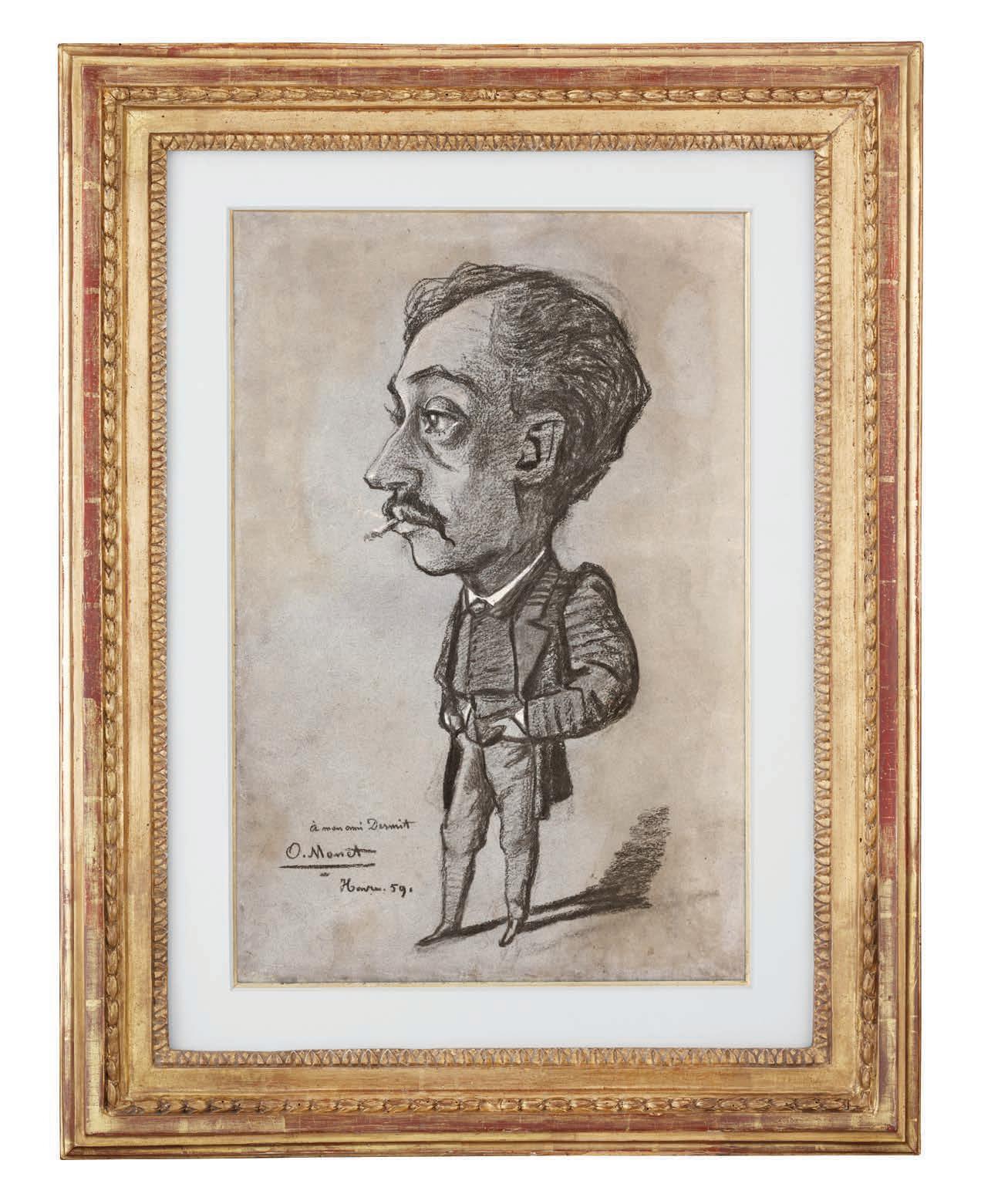

msrau.com • Best of the Best • 9


10 • Best of the Best • 866-349-0378

PABLO PICASSO
Buste d’homme barbu
Captivating and expressive, the iconic modern master captures the intensity of his subject’s gaze with abstract swathes of paint in this large portrait.
Combining saturated color with decisive restraint, Buste d’homme barbu showcases Pablo Picasso’s highly expressionistic, emotive take on the standard portrait. The painting is part of an important series of portraits of bearded male faces painted by the artist during the last few years of his life. Said to be a reflection of both himself and also his father, these works are among the most personal and intimate of Picasso’s career as he questions his legacy and mortality.
Here, the iconic artist fragments his figure’s face into basic shapes, exercising his Cubist expertise by utilizing just a few choice brushstrokes to build an identifiable visage. Picasso composes an expressive set of facial traits with decisive swoops of color, creating the contours of a cheekbone and the shadow of a nose.
The artist endows his figure with a powerful, hypnotic gaze — the mirada fuerte that he notably included in many of his portraits. Perhaps a self-referential nod, Picasso himself was personally known for projecting a strong gaze. Works in this series also often referenced the artist’s father, Spanish painter José Ruiz y Blasco. Picasso once said, “Every time I draw a man, I find myself thinking of my father… To me a man means ‘Don José,’ and it will always be so, all my life… He wore a beard… All the men I draw I see more or less with his features.”
While Picasso’s father’s dark mustache and beard are clearly distinguished in Buste d’homme barbu, works from this series served more as composite, archetypal figures representing different aspects of the artist’s identity and the identity of man as a whole. More than any other artist, Picasso’s everevolving, evocative style has come to define modern art of the 20th century, and this later work by the prolific master offers a glimpse into the psyche of the man himself.
Signed “Picasso” (upper right) and dated “8.4.65” (en verso) | Oil on canvas Canvas: 311/2”h x 251/2”w | Frame: 33”h x 271/8”w | #31-5479
12 • Best of the Best • 866-349-0378


msrau.com • Best of the Best • 13

 JACOB LAWRENCE
JACOB LAWRENCE
Makeup
Highly referential, Lawrence’s captivating work displays the artist’s capacity to share his lived experiences through a robust understanding of art history.
Inspired by the famed Apollo Theatre in Harlem, Jacob Lawrence’s masterpiece Makeup takes viewers behind the curtain to a dressing room where African American actors prepare for their performance. The vibrant scene features a row of mirrors reflecting the actors’ exaggerated expressions in the style of African masks. These masks not only allude to the symbolic masks of theatre, comedy and drama, but also pay homage to the Cubist masterpieces of Pablo Picasso. Meanwhile, in the foreground, a pair of performers engage in a lively game of cards, linking the composition to another modern master, Paul Cezanne, and his famed work, the The Card Players
Lawrence spent his formative years living in Harlem during the prime of the Harlem Renaissance and quickly developed a love for art and a passion for art history. These influences are clear in the dynamic, personal and referential composition of Makeup. The work is part of the artist’s Performance series, which explored the contrasts between the public and private lives of African Americans in the 1950s. Depicting brass bands, vaudevillians and magicians, as well as the intimate, hidden moments shared by performers behind closed doors, the series debuted at the Downtown Gallery to critical and commercial success.
Lawrence’s career was a groundbreaking triumph. He was the first Black artist to have their artworks acquired for the MoMA’s permanent collection in 1941, and was also the first to be commissioned by the U.S. government to create paintings for the public works of the New Deal. His powerful artworks were exhibited widely during his lifetime. Today, Lawrence’s artworks are held in over 200 museum collections worldwide, including the Metropolitan Museum of Art, the Whitney Museum of American Art, the Smithsonian and the Museum of Modern Art.
Signed (lower right) | Tempera on board | Painted 1952 Board: 211/4”h x 27”w | Frame: 30”h x 34”w | #31-5981
EXHIBITED
New York, Downtown Gallery, Performance: A Series of New Paintings in Tempera by Jacob Lawrence, 1953
New York, Whitney Museum of American Art, Annual Exhibition of Contemporary American Sculpture, Watercolors and Drawings, 1953 Richmond, Virginia Museum of Fine Arts, American Painting 1954, 1954 Philadelphia, Philadelphia Art Alliance, 1954-1955
New York, Coliseum, Art: USA: 59, A Force, A Language, A Frontier, 1959 Brooklyn, Brooklyn Museum, Herbert A. Goldstone Collection of American Art, 1965
16 • Best of the Best • 866-349-0378


msrau.com • Best of the Best • 17
MARINUS VAN REYMERSWAELE
The Tax Collectors
Satirical scenes on material excess featuring two tax collectors counting coins were incredibly popular in 16th-century Flemish painting, but few compare to this.
This highly important early 16th-century Flemish painting depicts two tax collectors as they count their riches. In a quiet interior scene, the two miserly men sit at a green table covered in coins, jewels and empty moneybags. While the man in the red turban-like head wrap calmly records transactions in his ledger, his companion grimaces, still clutching an empty coin purse. A meticulous painter, Marinus took care to painstakingly render each minute detail with tremendous accuracy, precisely lining each garment fold and each wrinkle on the men’s faces and hands. He further demonstrates his skill by capturing the reflections of light within the reflective gemstones and brass candlestick. His treatment of the men’s faces is caricatured but still believable, setting up an excellent satire on the tax collectors. Overall, the artist has imbued the scene with a lifelike vibrancy with a bold palette and confident application of paint.
The economic and cultural boom of 16th-century Antwerp effectively made the once-small Flemish city the financial center of the world. The greatest artists from all over the continent were drawn to the prosperity and sophistication of Antwerp. Without a doubt, a scene of two misers would have been immediately recognizable to a 16th-century European. The subject was one of the most popular of its time, gracing the collections of queens, kings and private citizens alike. All would have understood the image as satirical, poking fun at the two tax collectors wearing gaudy, outdated clothing with contorted faces. Despite these political and economic grievances, viewers could share a laugh at Marinus’s painting depicting the two men who served this oft-despised role.
Marinus van Reymerswaele stands among the greatest and most beloved artists of 16th-century Antwerp. Dutch by birth, he spent the majority of his life living and working in the city. In 1509, he registered with the Antwerp Guild of St. Luke, cementing his position within the artistic fabric of the city. One version of Marinus’s Tax Collectors resides in Windsor Castle, within the king’s private quarters, and the Royal Liechtenstein collection acquired its own in 2008. It, like ours, displays the same remarkable color and expressive faces that characterize our masterpiece. Of these comparable paintings, only the Royal Liechtenstein example is equal to ours in quality and condition.
Oil on panel | Circa 1540
Panel: 42”h x 313/4”w | Frame: 481/2”h x 385/8”w | #31-5668
PROVENANCE
Private collection, United Kingdom, acquired circa 1880 | By direct descent to private collection
Private collection, New Orleans
18 • Best of the Best • 866-349-0378







msrau.com • Best of the Best • 19
PICTORIAL KEY FOR THE TAX COLLECTORS
1. The green parrot is the most unique element in this painting. Imported from either India or South America, exotic pets such as this parrot showed the worldliness and wealth of the owners, and its inclusion here demonstrates the tax collector’s ostentation.
2. An open box with the inscription Cuelen indicates the box of standard weights and measures, utilized by moneychangers for evaluating the weight of individual coins for their worth. The word Cuelen translates to Cologne, the German city that was the leading producer of such standards. The weights allowed moneychangers to ensure that the weight, and thus the value, of the coins remained unchanged and that coins had not been clipped for gold and silver scraps.
3. The wooden box is overflowing with the tax papers of the past with their wax seals. This detail represents that no matter how much money the tax collectors take, they will never be satisfied.
4. The artist renders the candle in a brass candlestick, paying meticulous attention to the reflections of light on the metal. The candle has just gone out, symbolizing memento mori and the fleeting qualities of life.
5. The ledger writer wears a headwrap, featuring a large Renaissance brooch displaying both pearls and a ruby in its gold setting. The ruby historically protected the owner’s assets and assisted in the accumulation of wealth. The pearls imply that the sitter was imperfect as the natural pearls of the day were almost never perfectly round. The gold further underscores the men’s wealth.
6. The primary tax collector’s sartorial finery is both archaic and pretentious. His glasses, carefully rendered to cast the
most subtle of shadows onto the man’s face, represent moral short-sightedness. At the time this image was painted in the early 1500s, this style of clothing with sumptuous drapery, large turban bonnets and fur trim would have been outdated, a relic of fashion from a century prior. As part of the painting’s satire, the artist mocks the pair’s gaudy and out-of-fashion clothing.
7. The writing on the tax collector’s ledger is legible, written in Dutch, and enumerates collected taxes, which indicates the patron and purchaser of this painting was likely from the Netherlands
8. This details shows the sandbox and quill case which was necessary for the ledger writing.
9. The inkwell is covered by rubies, emeralds and pearls, underscoring that Antwerp was the center of all trade. These gems would have come from across the globe. Emeralds originated in South America, particularly from the Colombian mines; rubies came from Burma deep in Asia and the pearls hailed from the South Seas. Next to the jewels, the artist has rendered some cotton. Typically used to symbolize purity, the “pure” cotton is somewhat soiled. This rare detail only appears in a few versions of this famed image.
10. Perhaps the most important item on a tax gatherer’s table is the money itself. Marinus meticulously renders the coins in tremendous detail, including the clearly visible gold double ducat of Guglielmo II Paleologus, the marquis de Montferrat who reigned 1494–1518, as well as an assortment of English and German coins. The second man in the painting, with a contorted facial expression, has just emptied the coins onto the table. He looks directly at the viewer, pointing at the ledger as if to demand further compensation.
20 • Best of the Best • 866-349-0378

1 2 3 5 6 7 8 9 10 4


SIR WINSTON CHURCHILL
Trees in the Eastern Counties
“If it weren’t for painting, I couldn’t live; I couldn’t bear the strain of things.”
—Sir Winston Churchill
Immediately recognizable as one of the most important statesmen in world history, Sir Winston Churchill also pursued the art of painting for more than 40 years. This pastime resulted in an impressive collection of works that give insight into the personal life of this tremendously important man. This particular work of art, entitled Trees in the Eastern Counties, originally hung in Churchill’s Hyde Park Gate home in London and was composed during a visit with family in Norfolk. Painted at the Breccles Hall estate of Mrs. Edwin Montagu, cousin to his wife, Lady Clementine Churchill, to which the Churchills were frequent visitors, Churchill deftly captures a bright, windswept day with bold and energetic brushstrokes.
Painting was a dominating passion for Churchill in the last half of his life. There is little evidence that he had any artistic training prior to his 40s. In fact, his wife Clementine mentioned at one point that before he began painting, Churchill had hardly visited an art museum, much less created art. Churchill first began painting following a personal and political disaster — the Dardanelles campaign in 1915 — as he found creating art to be a reprieve from the stressors of his storied life.
In 1959, Churchill was bestowed the prestigious recognition of a retrospective at the Royal Academy of Arts, and out of the roughly 500 works he had completed over his painting career, he selected this composition for the exhibition. Finding an original composition by Churchill, particularly one of such quality and personal importance to the artist, is exceedingly rare, as Churchill did not sell his artworks. He preferred to give his paintings as gifts to esteemed friends and colleagues, and the majority remain in private collections. The revered figure gave Trees in Eastern Counties as a gift to his wife, who inscribed the back of the painting with a personal note.
Inscribed by Lady Clementine Spencer-Churchill “Painted by my Husband / Clementine S. Churchill” (en verso) Oil on canvas | Circa 1936 | Canvas: 241/8”h x 291/2”w | Frame: 31”h x 361/4”w | #31-3502
PROVENANCE
Lady Spencer-Churchill | Private collection | Private collection
EXHIBITED London, Royal Academy, 1959
24 • Best of the Best • 866-349-0378


msrau.com • Best of the Best • 25


PIERRE BONNARD
Jeunes femmes dans la rue
“I have all my subjects at hand…I go and look at them. I take notes. Then I go home. And before I start painting I reflect, I dream.” —Pierre Bonnard
Three captivating women promenade down a Parisian street in Pierre Bonnard’s mesmerizing painting, Jeunes femmes dans la rue. Basked in a golden yellow sheen, the energetic composition simultaneously evokes the joie de vivre of Paris and also a sense of intimacy. The artist articulates each figure in close range with individualizing details, suggesting a fond familiarity with his subjects.
The three women are, in fact, Bonnard’s most cherished lovers — Marthe, Renée and Lucienne. Marthe, the artist’s primary muse, eventually became his wife, while Renée and Lucienne remained his dearest mistresses. An exceptional oil on canvas, Bonnard renders his ménage with deft brushstrokes, utilizing cool blue and green background tones to magnify the vibrant warmth emanating from his beloved subjects. While Bonnard’s works often depicted just one or two of his lovers, this painting includes all three in a single canvas. Thus, the painting became one of Bonnard’s most treasured works. This most favorite painting stayed in the artist’s personal collection until he passed away in 1947.
Pierre Bonnard studied art at the Académie Julian, where he met Vuillard and Maurice Denis — together, they would form the influential Les Nabis artistic movement, a group that emphasized the use of color. The artists found inspiration in Symbolist poetry and Japanese art. As a well-respected artist, Bonnard was a great friend of and admired by artists, including Henri Matisse and Henri de Toulouse-Lautrec. The geometric composition of Jeunes femmes exudes a modernity further embodied in Bonnard’s rich palette. Bonnard is a recognized master of the Post-Impressionist movement. His works grace the collections of major museums around the world, including the Metropolitan Museum of Art, the Tate Modern, the Musée d’Orsay, the MoMA and the Art Institute of Chicago, among others.
Signed “Bonnard” (lower left) | Oil on canvas | Painted 1922 Canvas: 29”h x 23”w | Frame: 371/2”h x 311/4”w | #31-5905
PROVENANCE
Estate of the artist | Private collection of Marthe Bonnard (wife of artist) By descent to private collection of Sisters Bovers (nieces of Marthe Bonnard) Private collection of Euguege Verchere, Geneva | Private collection, Geneva Private collection, Toronto
28 • Best of the Best • 866-349-0378


msrau.com • Best of the Best • 29
HENRI MATISSE
Vue de Belle-île
“These ‘proto-Fauve’ paintings suddenly reveal the nature of Matisse’s genius as a colorist: his using color not to imitate light, but to create it.” —John Elderfield, Chief Curator at MoMA
A kaleidoscope of color and texture, Henri Matisse’s Vue de Belle-île captures the sublime beauty of its namesake — a small island off of the Brittany coast. This painting, sometimes described as “proto-Fauve,” reflects a pivotal moment in the artist’s career when he began to turn away from a traditional style using muted colors to experiment with a more creative and vibrant palette.
Matisse made his first pilgrimage to Belle-île in 1895. Initially, the task of capturing the unbridled power of the rough seas and rugged coast intimidated the young painter; however, he returned the following summer, determined to master his renderings of the seaside landscape. He befriended John Peter Russell, an Impressionist painter who founded an artists’ colony on the island that was frequented by Claude Monet and Vincent Van Gogh. Russell taught Matisse how to utilize the island’s diverse topography and climate to study the nuance of both tone and light.
Matisse’s Vue de Belle-île is a celebration of color and texture. White-washed structures glow with purple and pink refractions of the afternoon sun. Green hillsides are speckled with strokes of orange and splashes of yellow. Punctuated by painterly brushstrokes that alternate from short Divisionist-like lines to saturated swathes of paint, this colorist work nearly veers into abstraction.
The works Matisse created during his pivotal summers on the island offer a rare glimpse into the artist’s mind as he found his singular artistic voice. Vue de Belle-île was exhibited at the Palais des Beaux-arts in Lille in 1950 for the important exhibition Un Demi-siècle de peinture française 1900-1950. Additional paintings from Matisse’s time at Belle-Île are held in the collections at the Musée des Beaux-Arts de Bordeaux in France and the Dixon Garden and Galleries in Memphis, Tennessee. These coveted compositions reveal Matisse’s nascent early genius as an experimental colorist.
Stamped “Henri Matisse” (lower right) | Oil on canvas | Dated 1897 Canvas: 181/8”h x 213/4”w | Frame: 231/4”h x 267/8”w | #31-6195
30 • Best of the Best • 866-349-0378


msrau.com • Best of the Best • 31


CHILDE HASSAM
The Bather
Capturing a nude in an ethereal forest setting, Childe Hassam demonstrates a kinship with his French Impressionist contemporaries as well as his own skill in composition and color.
Considered by many to be America’s foremost Impressionist painter, Childe Hassam composed his tranquil and intimate oil on canvas The Bather in the early years of the 20th century. The creation of the artwork aligns with a period of Hassam’s career where the artist’s palette was transforming, matching ever closer with the pale and pastel hues of French Impressionists like Claude Monet. Even the subject — a nude woman — represents a greater alignment with the Impressionist project, as artists of the movement and their non-mythological and non-biblical nudes still generated cries of indecency. With Hassam’s thick impasto, signature brushwork and attention to color, The Bather serves as a dreamlike vision, serene and sensuous, of a young woman bathing in a lush forest.
While the artist’s skill for landscape painting is on display, it is Hassam’s command of form, light and color that brings this canvas to life. He creates a captivating composition, placing the nude subject in the bottom left of the canvas. The soft, undulating curves of the woman’s body in contrapposto and the glow of her fair skin are balanced by the strong verticals and deep earth tones of the tall trees to her right. Hassam delicately frames the nude in the vivid blues of the distant water, building luminous color that further draws the viewer’s eye and results in a somewhat voyeuristic appeal — endowing his nude with both a natural innocence and an intentional sensuality.
Born in Dorchester, Massachusetts, Childe Hassam began his artistic career as a freelance illustrator, working for national publications including Harper’s Weekly, Scribner’s Monthly and The Century. His first solo exhibition of watercolors took place in Boston in 1883, and he quickly catapulted onto the international scene, winning a bronze medal at the Exposition Universelle in Paris in 1889. A true master, Hassam depicted a way of life characteristic of both American and French society, and his work elucidates a critical chapter in American art history. Today, his work resides in the Oval Office of the White House and numerous important museums, including the Metropolitan Museum of Art in New York, the National Gallery of Art in Washington, DC and the Museum of Fine Arts in Boston, among others. This painting will be included in Stuart P. Feld and Kathleen M. Burnside’s forthcoming catalogue raisonné of the artist’s work.
Signed “Childe Hassam” (lower right) | Oil on canvas | Circa 1905 Canvas: 241/2”h x 201/8”w | Frame: 357/8”h x 311/4”w | #31-6184
PROVENANCE
Private collection of William Young Marsh, Esq., Williamstown, Massachusetts Private collection, Montreal | Walter Klinkhoff Gallery, Montreal, Canada Private Collection, Palm Beach, Florida | Private collection
34 • Best of the Best • 866-349-0378


msrau.com • Best of the Best • 35


EMIL NOLDE
Marschlandschaft (mit drei Hausern)
A vibrant watercolor landscape, this composition showcases the meditative expressionism of Nolde’s approach to painting in this medium.
Suffused with rich color and unbridled emotion, Marschlandschaft invites the viewer directly into the intuitive, poetic inner world of Emil Nolde. An essential artist in the German avant-garde, Nolde’s highly modern oeuvre positions the artist as one of the most prominent German Expressionists. With its vivid palette and expressive saturations of paint, Marschlandschaft is an exemplary representation of Nolde’s evocative style.
The composition features brilliant, amorphous fields of color that suggest the vast, marshy landscape of Nolde’s native Schleswig-Holstein, a region near the German-Danish border. The artist applies paint with dramatic effect, rendering passing storm clouds that allow light to peek through and illuminate the colors of his landscape. On painting, Nolde once mused, “I try to avoid all thinking. A vague concept of color and luminosity suffices, and the picture evolves during the act of painting.” The unpredictable spontaneity of watercolor certainly lent itself well to this intuitive artistic approach and Nolde achieved a unique vibrancy in the medium that is unsurpassed by fellow watercolorists.
Nolde participated in the seminal group Die Brücke (The Bridge), one of the earliest artists’ associations which had a crucial impact on the development of modern art. His interplay of color and form set him apart from his contemporaries, and his work is recognized as a monumental step toward modernism. These revolutionary techniques brought attention from the most infamous detractor of modern art — Adolf Hitler. Much of Nolde’s oeuvre was marked as “degenerate” by the Nazi regime, and his artworks were confiscated and destroyed more than any other artist.
Despite this adversity, Nolde received numerous awards throughout his career, including the Print Prize of the XXVL Venice Biennale and the Order “Pour le mérite,” the highest achievement for German arts and sciences. Today, Nolde’s works are held in important museum collections internationally, including in the Art Institute of Chicago and the Museo Nacional Thyssen-Bornemisza.
Signed “Nolde” (lower right) | Watercolor on Japan paper | Circa 1920 Paper: 131/2”h x 181/2” w | Frame: 255/8”h x 30”w | #31-5395
38 • Best of the Best • 866-349-0378


msrau.com • Best of the Best • 39
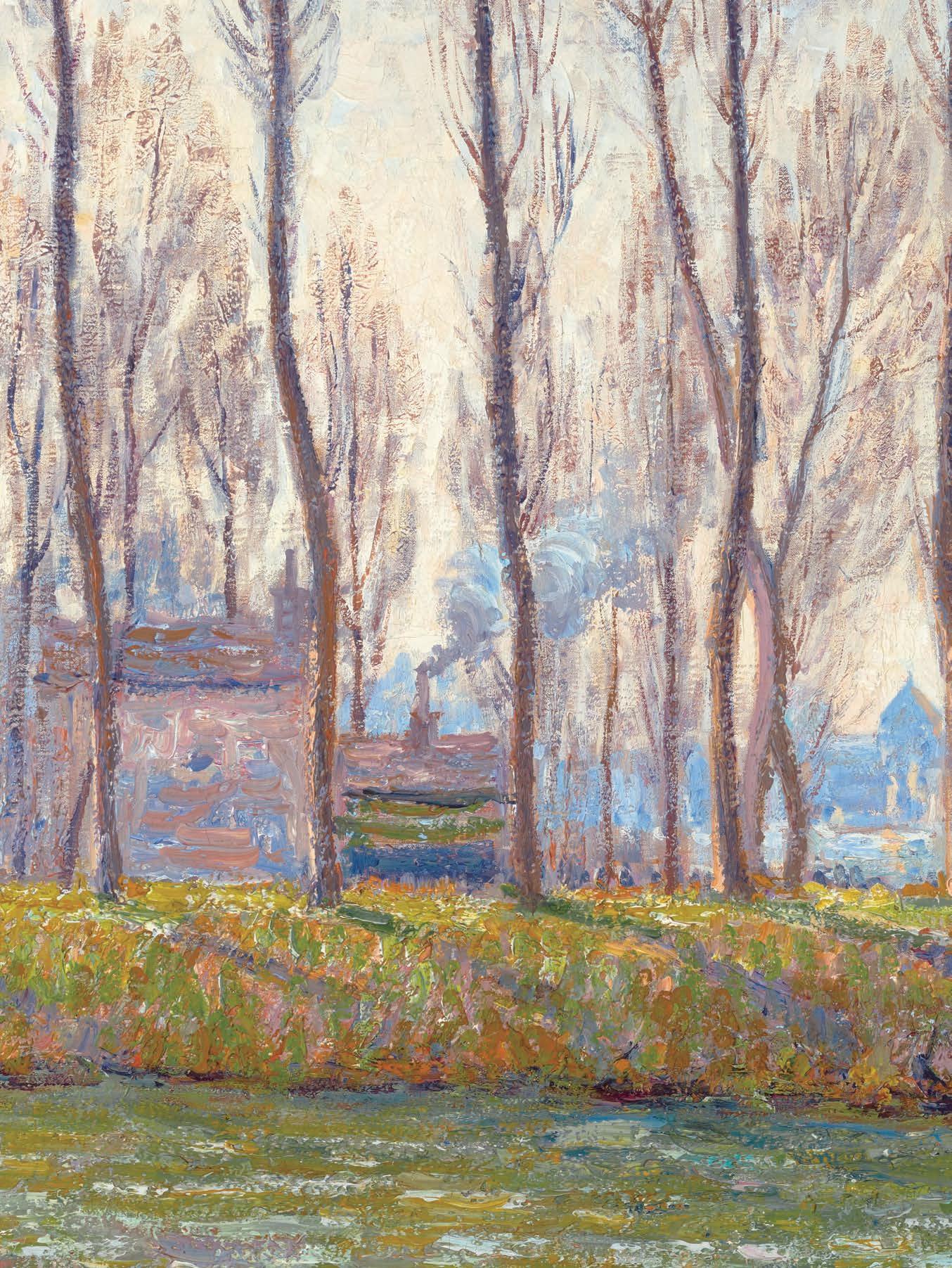

FRANCIS PICABIA
Moret-sur-Loing, en hiver
“The world of art is a richer, more complicated, more unpredictable place because of him.”
— Ann Umland, Senior Curator at MoMA
An artist remembered for his artistic brilliance, Francis Picabia spent his extraordinary career defying convention. Evocative and avant-garde, his incredible oeuvre reveals the breadth of both his talent and creativity. Known also in the annals of art history as one of the founders of the groundbreaking Dadaist movement, his artistic style ranged broadly throughout his career, from abstraction to photorealism to Impressionism to Classicism. Brilliantly hued and wildly expressive, this oil on canvas dates to his early years as a painter and is a stunning example of his foray into the Impressionist style.
Having met the two sons of the legendary Impressionist Camille Pissarro in 1902, Picabia eagerly took up his brush to paint his own landscape scenes executed en plein air. Freely composed, Picabia’s Moret-sur-Loing, en hiver is a testament to his mastery over the highly lauded style. Soft pastel shades of pinks and blues intermingle with the more vibrant yellows and greens of the grass, while the bold brush strokes convey the immediacy of the fleeting moment. With a freedom of expression that is unique to his oeuvre, Picabia expertly captures the sensations of the waterscape.
By 1905, Picabia achieved such success with his Impressionist works that he began to display the pieces in Salons throughout Paris. They were enthusiastically received by critics, who praised Picabia as the next great French landscape master. Even the French government purchased one of his works, which was considered a great honor for such a young painter.
Yet, as quickly as Picabia took up the Impressionist style, he turned away from it, and by 1908 elements of Fauvism and Cubism began to appear in his painting. His near-constant evolution would continue throughout his career, and his predictably unpredictable canvases have come to define his art more than any single iteration of style. His free spirit and almost nihilistic attitude towards his art most famously resulted in Dada, the movement he co-founded with Marcel Duchamp and Guillaume Apollinaire. A true Renaissance man, mastering any style with which he tried his hand, the broad spectrum of Francis Picabia’s oeuvre can be enjoyed at international museums from the Museum of Modern Art in New York, the Tate Gallery in London and the Musée National d’Art Moderne in Paris, among others.
Signed “Picabia” (lower right) | Oil on canvas | Circa 1907 Canvas: 211/2”h x 255/8”w | Frame: 323/4”h x 371/8”w | #31-5397
EXHIBITED
Paris, Galerie Haussmann, Exposition F. Picabia, 1907
42 • Best of the Best • 866-349-0378


msrau.com • Best of the Best • 43


44 • Best of the Best • 866-349-0378

GIOVANNI BOLDINI
Portrait of Lucie Gérard
Marked by his sitter’s coquettish smile and enduring gaze, this portrait is one of the finest examples of Boldini’s distinctive gestural style
Composed by Giovanni Boldini, one of the most important portrait artists of the Belle Époque, this arresting portrait captures the likeness of Lucie Gérard, a French silent film and stage actress. With its fast, expressive linework, the pastel displays Boldini’s talent for depicting the glamour of Parisian high society. The artist’s choice of a more subdued color palette infuses the work with a distinctive modernity and also brings the intensity of his sitter’s alluring gaze into focus.
Lucie Gérard was one of the most famous figures of her day, appearing in operas, plays and films. Her beautiful face was commonly immortalized on French postcards and seen in advertisements. Boldini was acquainted with his famous sitter and captured her likeness with more personal depth, rendering her commanding countenance as her lips begin to curl into a coquettish smile. Boldini draws his sitter as the epitome of the modern Parisian woman–elegant, confident and sophisticated with a slight air of mischievous dalliance. The portrait is a superb example of the genre, combining the intimacy of capturing the specific physical traits and personality of the sitter with the distinctive gestural style for which Boldini was celebrated.
Along with John Singer Sargent and James McNeill Whistler, Boldini was the most highly sought after modern portraitists in Europe and America. Dubbed the “Master of Swish” by Time magazine for his painterly style, Boldini is regarded among the best of his genre, and today his works can be seen in important museum collections such as the Metropolitan Museum of Art, Musée D’Orsay, National Gallery of Modern Art in Rome, Palazzo Pitti in Florence and others.
Signed “Boldini” (lower right) | Pastel on canvas | Circa 1890 Canvas: 221/4”h x 185/8”w | Frame: 295/8”h x 257/8”w | #31-5664
PROVENANCE
Galleria La Fenice, Venice (their label formerly on the old backing board)
Private collection, Paris | Anonymous sale, Paris, Hôtel Drouot, 1988 Private collection, France | Private collection, Rome
EXHIBITED
Paris, Hôtel Jean Charpentier, Boldini, 1931, no.55
46 • Best of the Best • 866-349-0378


msrau.com • Best of the Best • 47


ALEXANDER CALDER
Rouille sur journe
This exceptional work captures Calder’s signature colorful whimsy in bold splashes of gouache and ink.
A vibrant and playful confection of color and movement, this gouache and ink on paper exemplifies the singular point-of-view of modernist master, Alexander Calder. Widely regarded for his innovations across a multitude of artistic mediums, Calder’s rare painted works offer an intriguing glimpse into this renowned artist’s conception of spatial planes and color theory. In this piece, Calder beautifully illustrates his preoccupation with both organic shapes and dynamic movement.
Painted in 1964, this important work embodies the exuberant spirit of his oeuvre. Also known for introducing a new idiom into the modern narrative – sculptural mobiles – Calder’s painted works reflect his groundbreaking new perceptions of line and space. The present work is an exceptional example, impressive in size, vivid color and compelling composition. With geometric components that seem to float within the canvas, this remarkable work boasts the same graceful whimsy of Calder’s hanging sculptural mobiles.
Extraordinarily important in terms of both its medium and artistic style, this work also underscores the significant influence of Joan Miró on Calder’s artistic development. These two 20th-century greats met in Paris in the 1920s, forming an artistic bond that would influence both artists throughout their entire careers. Together, they were integral in constructing a new avant-garde vernacular that shifted away from figural modes of representation towards a more illusory, abstract style derived from nature and the imagination.
Today, Calder’s remarkable works can be found in public and private collections worldwide, including the Whitney Museum of American Art in New York, Museum of Modern Art in New York, Centre Pompidou in Paris, and National Gallery of Art in Washington, D.C. Important public commissions by the artist can also be seen in cities throughout the world, and his remarkable oeuvre has been the subject of hundreds of museum exhibitions. Similar paintings by Calder can be found in important museum collections, such as the Museum of Modern Art and the Guggenheim in New York.
Signed “Calder 64” (lower right) | Gouache and ink on paper | Dated 1964 Paper: 42”h x 29 1/8”w | Frame: 52 1/4”h x 39 1/4”w | #31-5611
50 • Best of the Best • 866-349-0378


msrau.com • Best of the Best • 51
AMEDEO MODIGLIANI
Tête de cariatide

Known for his idiosyncratic stylizing of his subjects, Modigliani’s sculptures are exceedingly rare, with the majority residing in museums.
The figural works of the iconic modernist Amedeo Modigliani are known for their instantly recognizable style, and they are among the most coveted in the world of art collecting. This monumental bronze, conceived by the artist in 1910, demonstrates his mastery of sculpture. Sculpting was the artist’s self-proclaimed first and true passion — a fact sometimes overlooked due to the success of his paintings and the overwhelming rarity of his sculptures. His famed Tête series from which this bronze hails stands as his most important sculptural output, with works recognized for their timeless quality and strong, stoic presence.
This monumental bronze is an enlarged casting of a wooden sculpture — the only known sculpture that Modigliani carved in wood rather than stone. Commissioned posthumously by Modigliani’s daughter Jeanne with the Modigliani Institute, this bronze enlargement perfectly captures the rich woodgrain texture of Modigliani’s original carving and retains its careful compositional balance even at its exceedingly impactful scale.

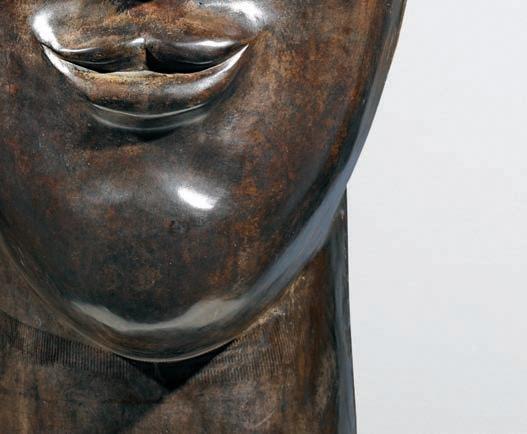
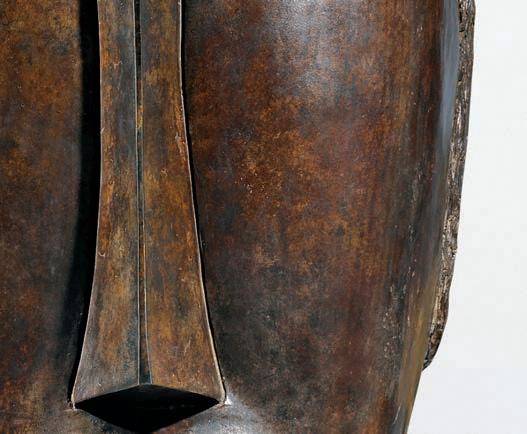

Much like contemporary Cubists like Pablo Picasso, Modigliani shared an interest in African art. The bronze is reminiscent of an African mask, with stylized features achieved by the work’s texture, meditative presence and sheer size. Yet the work also alludes to the artist’s Italian heritage and training. A caryatid is a staple of classical architecture, an ornate column typically found on the façade of a temple that takes the form of a female figure, with the most famous examples being on the Acropolis of Athens. Tête de cariatide exudes that same totemic and enduring quality.

Born in Livorno, Italy in 1884, Modigliani dreamed of becoming a sculptor from a young age when he first encountered the grand marbles of Michelangelo. Only after moving to Paris in 1906 and meeting modernist sculptor Constantin Brancusi in 1909, however, did the young artist begin carving figures. The artist’s premature death in 1920 limited his entire lifetime production to under 400 artworks, making his sculptures exceedingly rare and coveted. Despite only living to the age of 35, Amedeo Modigliani’s oeuvre resides in the world’s most prestigious collections, and other casts of Tête de cariatide reside in public collections in Rome, Morocco and Saudi Arabia.
Bears the foundry mark of Paolo Olmeda, signed “Modigliani” and numbered “1/8” | Bronze | Conceived 1910 Sculpture: 24”w x 34”d x 90”h | Base: 353/4”w x 453/4”d x 28”h | #31-4791


ANTONIO FRILLI
The Three Graces
Classic beauty and elegance define this exceptional Florentine marble sculpture.

Three nude women stand in an intimate embrace, their shapely bodies and serene expressions perfectly complemented by lustrous Carrara marble. The women, with their feminine forms tenderly rendered as epitomes of quiet elegance and youthful beauty, cast affectionate gazes upon each other, bringing a definitive humanity to an otherwise mythological scene. Antonio Frilli’s delicate treatment of the cascading fabric and gentle caress highlights the artist’s ability to achieve remarkably lifelike qualities in stone.
The Graces, also known as the Charites or Gratiae, played an essential role in ancient Greek and Roman mythology. While the Graces are best known for their charm, beauty and associations with nature and fertility, they were daughters of Zeus that primarily served as attendants to the gods and goddesses of Mount Olympus, often appearing in mythological feasts and dances. The divine trio has supplied endless inspiration for some of the most remarkable painters and sculptors throughout history.
Antonio Frilli first garnered his own acclaim in the late 19th century after opening his gallery in Florence in 1883. He participated in several World’s Fairs, and his expertise garnered him an international reputation. After his death in 1902, Frilli continued to receive accolades, with his sculpture Woman on a Hammock winning Grand Prize and six gold medals at the Louisiana Purchase exposition in St. Louis in 1904. Frilli’s legacy as an accomplished sculptor lives on with this virtuosic execution of The Three Graces, a lasting testament to his skill that makes him a rare and highly prized find among collectors today.
Signed “A. Frilli C / Firenze (Italia)” (on base) | Marble | Circa 1895 Sculpture on later base: 431/2”w x 27”d x 801/4”h | #31-5485
54 • Best of the Best • 866-349-0378


msrau.com • Best of the Best • 55
JEAN-BAPTISTE TUBY
Pair of 17th-Century Bronze Horses
The graceful artistry and inherent power of this equine bronze pair evokes the grandeur of the Sun King’s gardens.

This exceptional pair of bronze horses attributed to royal French sculptor Jean-Baptiste Tuby recalls the lavishly decorated gardens of the grand palaces of Louis XIV. One of the lead sculptors for the Sun King’s gardens, Tuby produced several marble and bronze groups for display at palaces including Versailles. These superb bronze horses were almost certainly cast to grace the lush gardens at one of the king’s famed residences. These bronzes masterfully capture the animals’ anatomy with a remarkable attention to detail. The horses, crafted with a graceful sense of power and dynamic movement, are a rare treasure of 17th-century French Baroque artistry.
Louis XIV’s palaces were built to reflect the grandeur of the king and his court, and the decorative sculptures and fountains were commissioned and meticulously placed to underscore this message. Originally created as part of a decorative fountain, these horse figures represent the mythical hippocampus, or seahorse, as evidenced by the flowing seaweed entangled in their hooves, manes and torsos. While this equestrian pair resembles a since-destroyed fountain sculptural group created by Tuby for Versailles, consisting of two hippocampi surrounded by Cupids and spouting water, they likely hail from another of Louis XIV’s country retreats — Château de Marly.
The gardens at Marly, like Versailles, had dozens of beautiful fountains. During the French Revolution, any bronzes were melted down in order to produce artillery and the overwhleming majority of Marly’s bronze sculptures are lost. The present figures relate to two horses that were part of a now-lost bronze fountain that once graced one of Marly’s ornamental pools. Considering the king’s preference for Tuby’s work, especially regarding fountains, there is a high probability that this work was created for the gardens of Marly.
Marble and bronze | Circa 1670 | Bronzes: 131/2”w x 141/2” deep x 24”h With pedestals: 611/8”h | #31-4690
56 • Best of the Best • 866-349-0378


ELKINGTON & CO. ELECTROPLATE
TABLE

Queen Victoria granted the renowned British firm Elkington & Co. the honor of replicating many royal silver items, including this highly decorative table.





This remarkable and historic parcel-gilt electroplate table hails from renowned British firm Elkington & Co., the distinguished company that invented the art and science of silver plating. By the 1830s, they were awarded a patent for this revolutionary technique, and within the next decade they had perfected it. The innovative technique and Elkington’s artistry were so impressive that Queen Victoria granted them the unique honor of replicating many items in the royal collection. This Elkington creation is one such example, and is the only known reproduction of a table that resides in Buckingham Palace.
While many electroplated items were small housewares or objets d’art, this impressive table measures over three feet high, adding to its rarity and prestige. Repoussé nymphs and fairies dance along the table’s surface, while the base is festooned with floral and foliate motifs and subtle gadroons. The combination of gold and silver plate is both elegant and technically marvelous.
Throughout the years, Elkington & Co. were granted royal warrants by Queen Victoria, Queen Alexandra, King George V, King Edward VII, Queen Mary and King George VI, among many others. They also supplied flatware to the luxury dining sections on the Titanic, as well as other vessels of the famed White Star Line luxury fleet.
Marked “Elkington & Co” and by designer “Morel-Ladeuil” | Silver | Dated 1868 403/4”h x 281/4”dia | #31-4711


msrau.com • Best of the Best • 59

60 • Best of the Best • 866-349-0378

msrau.com • Best of the Best • 61
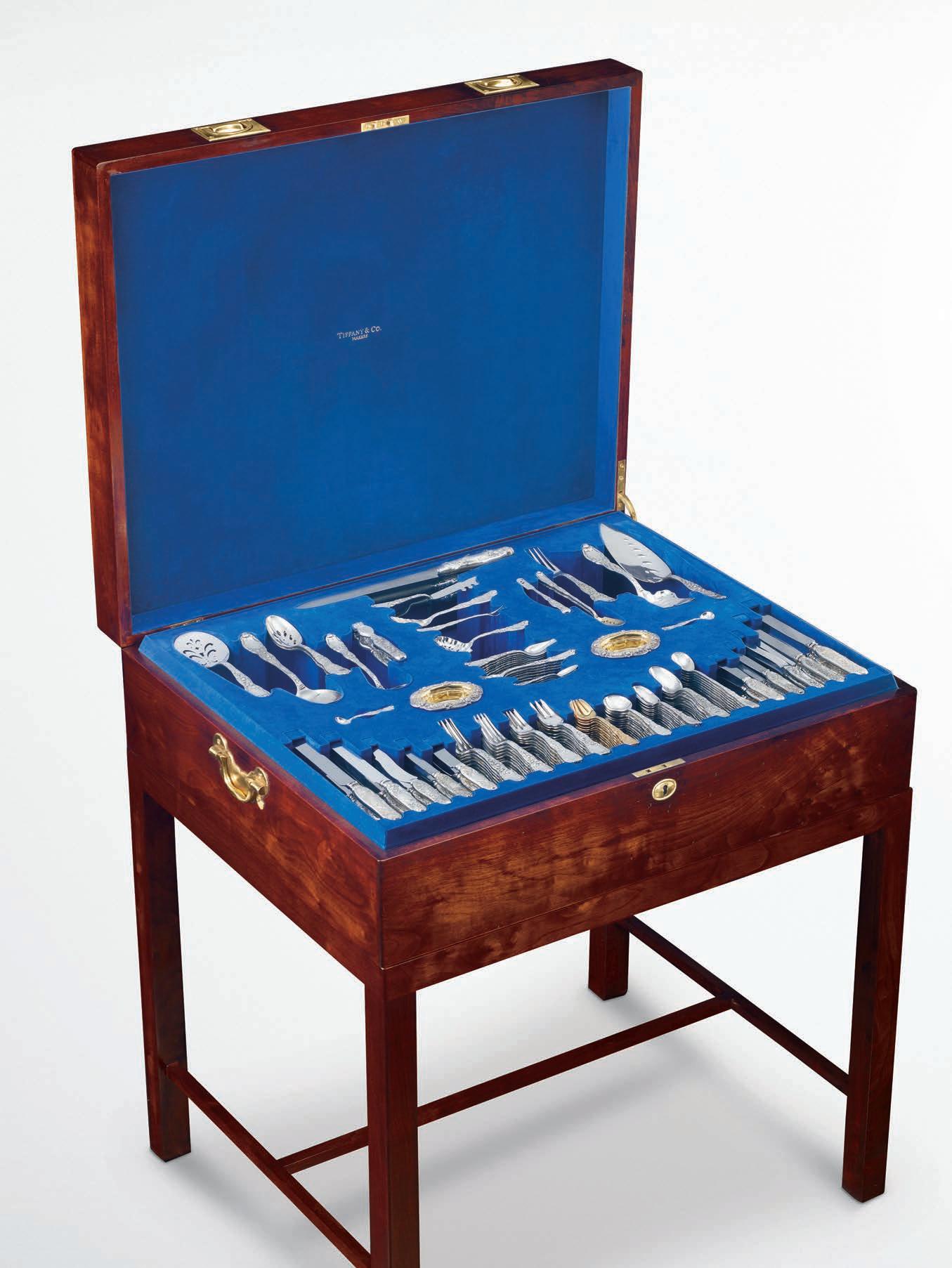

TIFFANY & CO. CHRYSANTHEMUM SILVER FLATWARE SERVICE
This grand flatware service for 12 stands as an enduring testament to the artistic vision and skill of Tiffany & Co.
This exceptional 226-piece antique Tiffany & Co. sterling flatware service for 12 features the highly desirable Chrysanthemum pattern. Introduced in 1878 and patented in 1880, the Chrysanthemum pattern is considered among Tiffany’s most beautiful and luxurious designs. The brainchild of renowned designer Charles T. Grosjean, the design is influenced by Japanese art, utilizing natural motifs that capture nature’s beauty. To find a set in such complete, pristine condition, nestled in its custom-fitted mahogany chest, is truly exceptional.
Charles T. Grosjean was one of the most influential silversmiths in Tiffany’s history, and his designs are among the most enduring of the Tiffany patterns. The son of a silversmith, he joined Tiffany as the manager of the company’s Prince Street silverworks and he quickly became a driving force in the overall success of Tiffany’s silver business. Chrysanthemum found particular favor with socialites and new brides despite the fact that it was one of the most expensive of the Tiffany patterns, with a nearly 35% price increase over other stock patterns due its intricate worksmanship. The pattern was carried over to many forms of hollowware as well, which also enjoyed tremendous popularity. Chrysanthemum is still considered the top pattern Tiffany & Co. ever produced.
This complete 226-piece set comprises: 12 entrée knives 12 luncheon knives 12 fish knives 12 butter knives 12 fruit knives 12 entrée forks 12 salad forks 12 luncheon forks 12 fish forks

12 oyster forks 12 ice cream forks 12 bouillon spoons 12 teaspoons 12 tablespoons 12 iced tea spoons 12 demitasse spoons 12 snub-nosed grapefruit spoons 3 piece carving set 2 slotted serving spoons 2 olive spoons 2 master salt spoons
2 master salt cellars 1 ladle 1 large serving spoon 1 tomato server 1 berry serving spoon 1 cheese knife 1 serving fork 1 asparagus tongs 1 nutcracker 1 small bon bon 1 fish serving fork 1 fish server
Utensils marked “Tiffany & Co. / Makers 6234 / Sterling Silver / 925-1000” with the date letter “M” Silver | Circa 1910 | Case: 333/8”w x 273/8”d x 9”h | On base: 36”h | #31-6120
msrau.com • Best of the Best • 63
ROYAL SILVER CALCUTTA RACES TROPHY

This stunning piece of royal horseracing history was presented to the winner of the 1933-1934 Calcutta Races on behalf of King George V.
Crafted by the silversmithing firm Goldsmiths and Silversmiths Company of London, the prestige of the premier Calcutta Races is reflected in this exceptional silver trophy. It is forged in a distinctive and elegant “pilgrim’s jug” shape, resembling the flasks early travelers tied to their horses’ harnesses on long pilgrimages to holy sites. The vessel is exquisitely decorated with gadrooned borders, classical masks and the engraved coat of arms of George V. This distinguished prize stands as an emblem of the pinnacle of equine sportsmanship as well as a brilliant example of English silver.
This trophy was presented to the winning horse’s owner, Mr. Edward Esmond — a leading name in the horseracing world of his day. Esmond’s horses won races across the globe, including the French Derby, the Grand Prix de Paris, the Prix de Diane and the Calcutta Races. Organized by the Royal Calcutta Turf Club, a horse racing organization founded in 1847 in Calcutta, British India, the latter was the most prestigious race in Asia and among the most important social events of the season, with the King himself often in attendance. The inscription reads, “Calcutta Races 1933-1934 / The King-Emperor’s Cup Presented by The King-Emperor / Won by Mr. Edward Esmond’s ‘Sans Ame.’”
Hallmarks for Goldsmiths and Silversmiths Company, London, 1928 | Silver 111/4”w x 41/2”d x 201/4”h | #31-5707
64 • Best of the Best • 866-349-0378


msrau.com • Best of the Best • 65
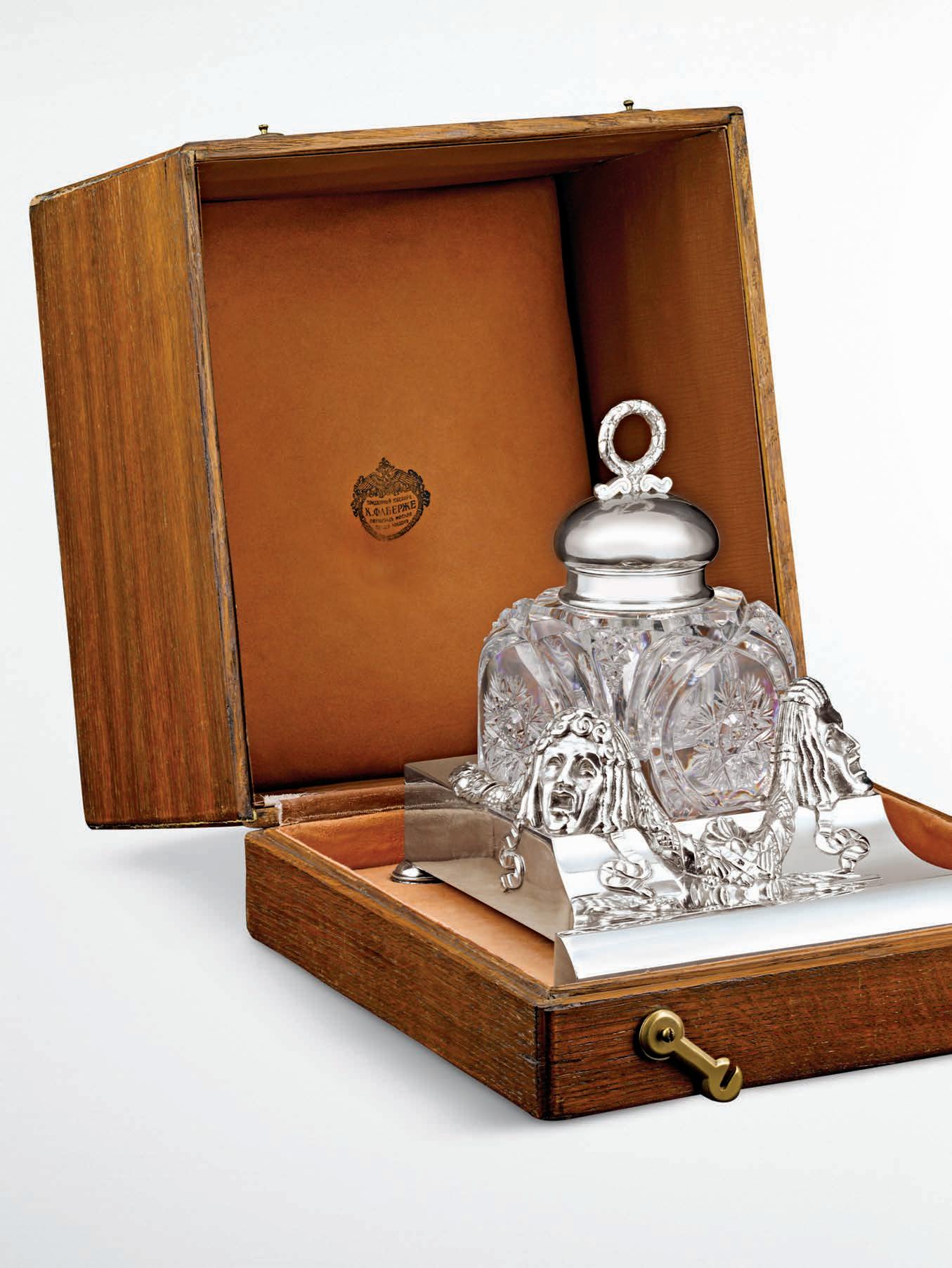

66 • Best of the Best • 866-349-0378
FABERGÉ SILVER AND CUT GLASS INKWELL
This inkwell embodies the masterful artistry of Fabergé and the elegant opulence of the last days of the Russian Empire.
Rare and luxurious, this exquisite silver-mounted cut glass inkwell crafted by legendary Russian artisan Peter Carl Fabergé epitomizes glamour and refinement. Comprised of intricately cut glass in a pinwheel pattern, the inkwell rests upon its silver base cast with dramatic masks, festoons and ribbons. The inkwell is topped with its silver lid featuring interior marks of the Fabergé stamp in Cyrillic and the Imperial warrant, 84 standard, dating these bottles to the final years of the Romanov’s Imperial Russia.
House of Fabergé built a devoted clientele, including members of the Romanov Imperial family, for whom this inkwell was perhaps crafted. In 1917, the Russian Revolution brought an end to the Romanov dynasty, the exile of Peter Carl Fabergé to Switzerland and a definitive halt to the original House of Fabergé. In the wake of the Revolution, many Fabergé treasures were lost or destroyed. Items of silver and gold, including the court and presentation pieces created for the Tsar, were melted down to mint silver ingots and rubles during the political and economic unrest, making surviving Fabergé silver from this time all the rarer.

This precious glass and silver inkwell is a reminder of the grandeur of Imperial Russia, the exceptional craftsmanship and artistry of Peter Carl Fabergé and an incredibly significant period in world history.
Presented in its original fitted Fabergé oak case | Silver | Circa 1910 Inkwell: 71/2”w x 81/4”d x 73/8”h | Case: 9”w x 103/8”d x 101/4”h | #31-6043

msrau.com • Best of the Best • 67
ITALIAN 18TH-CENTURY IRON SAFE
Incorporating a complex locking mechanism and wrought-iron reinforcements, this safe was regarded as the most secure way to store a business’ valuables.

Concealing hidden keyholes and secret panels, this Italian safe’s complex locking system highlights its exceptional craftsmanship. Featuring remarkable decorative ironwork elements on its exterior, including all-over hobnails, scrolling acanthus leaves and mandalic motifs, this safe is both functional and visually striking. A tricky puzzle, unlocking this safe requires three keys and a unique tool. In addition to its impenetrable locking system, the imposing safe weighs in at nearly 300 pounds.
New locking mechanisms developed in the 18th century, requiring more complicated, complex processes for anyone seeking to open a safe. These innovations, in combination with new industrial materials, allowed safes and other vaults to become indestructible and impenetrable without the proper keys and know-how. Vaults that utilize multiple keys are frequently referred to as “partners safes.” They were likely utilized by merchants and business owners of the period in place of banks, as all needed to be present with their own key for the safe to open. Beyond guarding one’s valuables and money from greedy thieves, safes also protected important documents in case of fire.
Iron | Late 18th century 44”h x 29”w x 16 3/4”d | #31-5982
Scan this code to watch a video of this safe opening


68 • Best of the Best • 866-349-0378



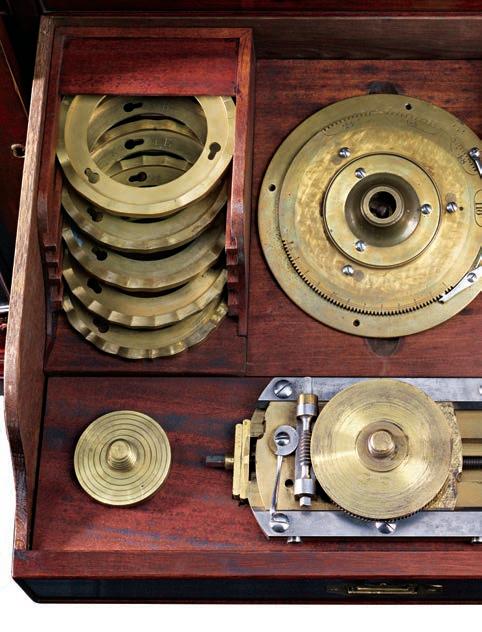


Scan this code to watch a video exploring this lathe’s features 70 • Best of the Best • 866-349-0378
HOLTZAPFFEL & CO. ORNAMENTAL TURNING LATHE

Imposing in its artistry, this one-of-a-kind ornamental lathe is the ultimate carving instrument, outfitted with all the necessary tools.
An essential tool in the creation and finishing of wood and objects, this 19th-century English ornamental lathe by Holtzapffel & Co. is additionally an object of beauty. Established in London in 1794, Holtzapffel & Co.’s lathes are considered among the finest ever made. The firm exhibited and won medals for its ornamental lathes at several World’s Fairs, including the Great Exhibition of 1851 and the International Inventions Exhibition of 1885. The lathe’s mahogany bench is operated by a foot treadle and includes a “Shepherd’s Crook”-style overhead spindle and a backboard toolbox containing various small implements.
Used since the time of the ancient Egyptians, the lathe is the ultimate carving tool capable of producing highly detailed objects of exquisite artistry. Set in motion by the large foot treadle, a complicated set of gears provides the power behind the machine. As the lathe turns, an artisan can use a plethora of tools, such as gouges and chisels to shape the object. This ornamental lathe is accompanied by a complete collection of wood cutting tools, including bits, cutters, gears, chunks and chisels, that allow for an endless array of decorative effects. The tools are contained within its matching 10-drawer triptych cabinet. A collection of Society of Ornamental Turners Bulletins is also included within the cabinet.
Mahogany | Late 19th century
Lathe: 421/8”w x 271/2”d x 89”h | Cabinet: 477/8”w x 255/8”d x 44”h | #31-1333

W.& A.K. JOHNSTON TERRESTRIAL 3 0-INCH GLOBE
The largest globe the Johnston firm ever created, this monumental terrestrial globe garnered the brothers international acclaim.
Measuring an impressive 30 inches in diameter, this globe was crafted by the renowned firm W. & A.K. Johnston. Founded in 1825, the Johnston firm is considered the foremost globe manufacturer of the second half of the 19th century, and this model was their crowning achievement as the largest they ever created. The entire surface area of a 30-inch globe is 525% larger than that of the average 12-inch globe, making its construction an extraordinary feat of artistry and craftsmanship. Enveloped in accurately detailed maps of the earth’s surface with extensive annotations for cities, this globe is among the largest and most attractive of its era.
Spheres of such grand scale were incredibly expensive to create. At a time when the world’s map was constantly changing, it proved to be much more cost effective to update one’s maps than to buy an entirely new globe. Though it was likely created decades earlier in the 1850s, its maps were last updated around 1890. It is held within a unique walnut and brass stand of exceptional quality, decorated with neoclassical carvings including lions’ masks and acanthus leaves.
The Johnston brothers, William and Alexander Keith, both worked for leading Scottish globe manufacturer James Kirkwood until the Great Fire of 1824 destroyed the firm. In 1825, William founded his own firm and was soon joined by his brother the following year, providing their combined services as geographers, engravers and printers. They quickly rose to the forefront of British globe manufacturing, receiving a royal appointment from Queen Victoria. In 1851, at the Great Exhibition, the brothers introduced their 30-inch globe design, the first of its kind ever produced in the British Isles. The firm remained intact even after the brothers’ deaths and continued to produce spectacular globes well into the early 20th century.
Bears Johnston cartouche | Walnut and brass | Globe and base circa 1851 | Map circa 1890 Globe: 30”dia | Base: 38”dia x 47”h | #31-3358
Scan to watch a video of this globe

72 • Best of the Best • 866-349-0378


msrau.com • Best of the Best • 73
GRAND DUCAL PIETRE DURE CONSOLE TABLES

Majestic and refined, the dazzling artistry of these tables is matched by their prestigious provenance.
These important Grand Ducal pietre dure console tables are in a class all their own. Their powerful architectural elegance, impressive size and rarity make them two of the finest hardstone masterpieces ever created and quite possibly the greatest pair of pietre dure tables in existence. These embellished tabletop panels showcase the splendid craftsmanship of the 17th-century Grand Ducal workshops in Florence.
While pietre dure plaques were typically crafted in small sizes because of their intricate details and level of workmanship, these incredible tabletops measure nearly 5 feet wide and 3 feet deep, providing a large canvas for floral designs accented with decorative hardstones such as lapis lazuli. Beyond the lavishly adorned tabletops, the tables’ 18th-century bases combine cupids, masks and scrolling vines carved by famous wood sculptor Andrea Brustolon.
The Grand Ducal pietre dure console tables were held at the renowned English country estate of the Lord Leigh family for approximately 250 years. A similar table currently resides in Buckingham palace, though it is of a smaller scale. Notable for their exceptional details and impressive size, these tables are fit for royalty.
Pietre dure tops: circa 1625-1650 | Bases: circa 1714 611/4”w x 39”d x 36”h | #31-5217
Scan this code to watch a video of Bill Rau exploring the history of these tables

74 • Best of the Best • 866-349-0378
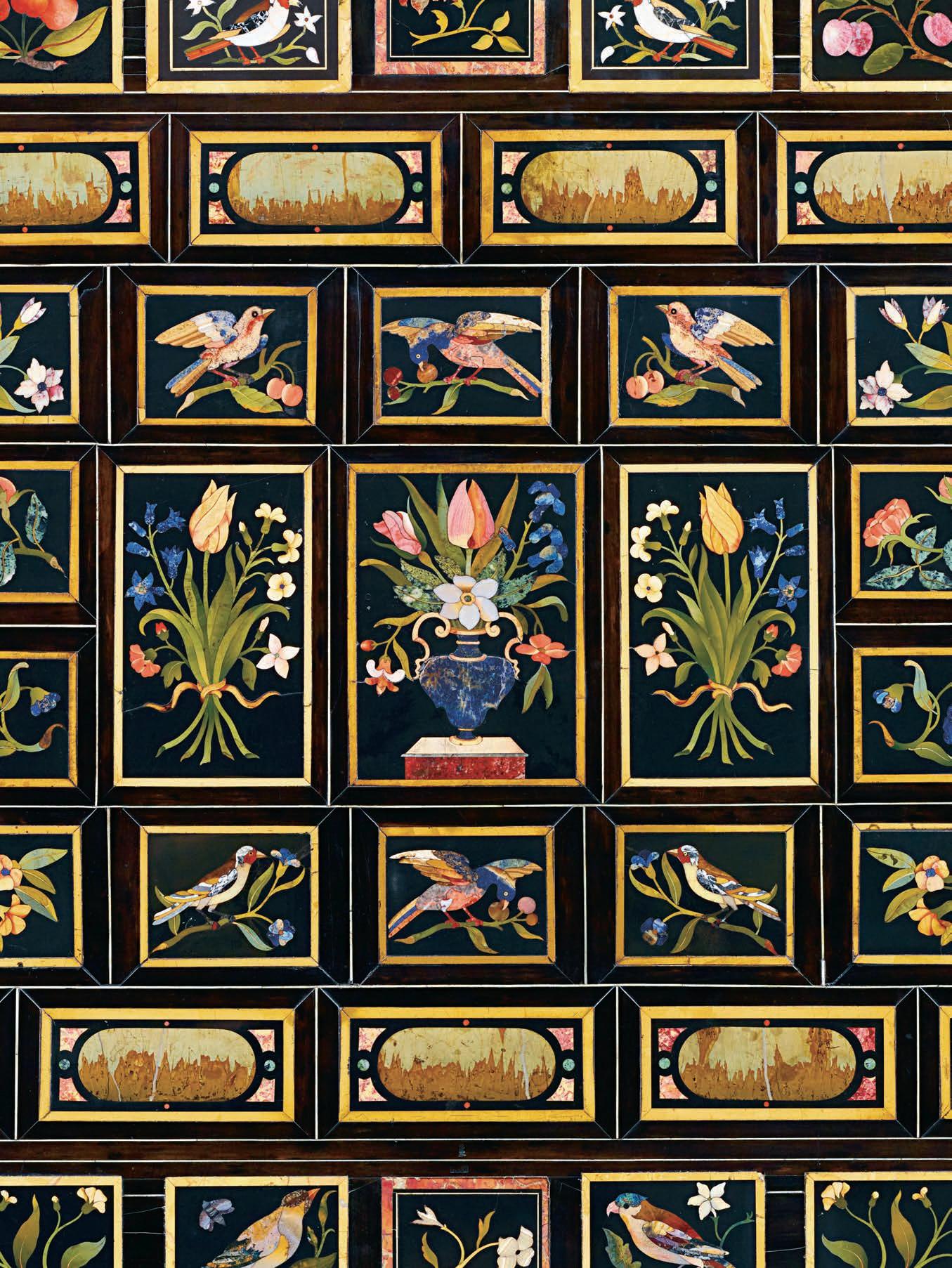

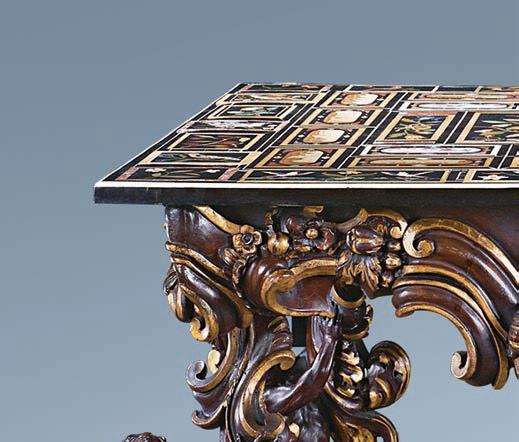




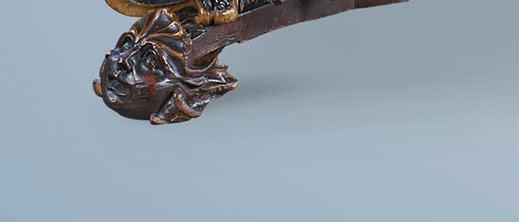


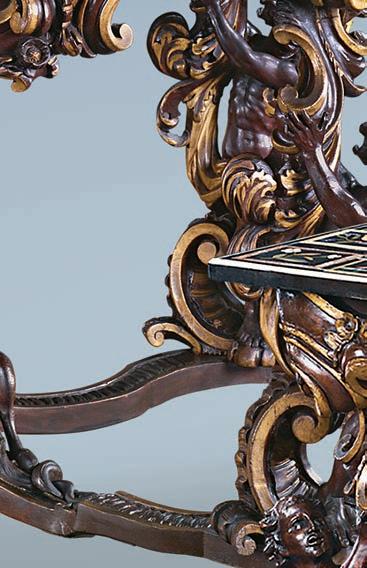

76 • Best of the Best • 866-349-0378

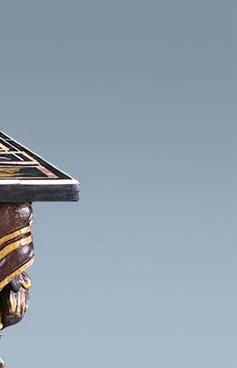

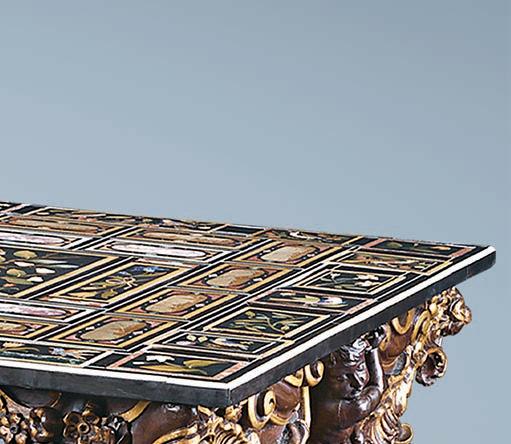







msrau.com • Best of the Best • 77
AZUL DA PARAÍBA
This magnificent, folio-accompanied Brazilian Paraiba tourmaline is a singular beauty.

The “Hope Diamond“ of Paraiba tourmalines, this monumental untreated 37.34-carat gemstone is the greatest of its kind ever mined. Glowing with a deep blue hue, the unprecedented grandeur of this Paraiba is heralded by an accompanying folio from the American Gemological Laboratories — the highest honor a gem can receive. In the book’s opening appendix letter Christopher Smith, president of the AGL, writes, “It is not likely that any more Brazilian Paraiba tourmalines of this importance will ever be unearthed.”
The astonishing rarity of the size and untreated color of this Paraiba would be difficult to overstate. With the exception of this gem, there are no other untreated Brazilian Paraibas over thirty carats known. Also, well over 99% of Paraiba gems are treated with a slow heat to further bring out their neon blue coloring. With its untreated perfect blue color and incomparable size, this gem is the paramount example of the Paraiba’s resplendant brilliance. The stone is complemented by a framing circle of pink diamonds totaling 1.50 carats and white diamonds totaling 9.19 carats.
AGL Folio | Paraiba: 37.34 carats | White diamonds: 9.19 carats 18K rose gold and platinum | Pendant: 2” length | #31-6271
Scan to watch a video of this monumental gemstone
Scan to view the AGL Appendix Letter


78 • Best of the Best • 866-349-0378


msrau.com • Best of the Best • 79
TIFFANY & CO. GOLCONDA DIAMOND RING
As if the ideal quality of this jewel was not impressive enough, the diamond features the highly desirable Asscher cut that further enhances its perfection.
An exceptional Asscher-cut Golconda diamond weighing a monumental 28.16 carats serves as the focal point in this elegant ring. The gem is certified by the Gemological Institute of America as not only having D color, but being a type IIa, meaning that the stone is 2-3 shades whiter than other D color diamonds. Further, the GIA certifies that the diamond is both Internally and Externally Flawless, with excellent polish and symmetry.
First discovered in the riverbeds of India in the 9th century, Golconda diamonds — also called type IIa diamonds — are known as the “Ultimate Diamond.” This is the only mine where all of the diamonds were nitrogen-free, making them clearer and whiter than every other diamond ever found.
The patented 74-facet step cut arrangement of the coveted Asscher cut results in a distinctive, sparkling effect called “the hall of mirrors” as it absorbs and reflects light from every angle. Set in a custom-made and signed Tiffany & Co. platinum setting, no detail was overlooked by the revered firm in creating a masterpiece to house a once-in-a-lifetime diamond find.

Marked “Tiffany & Co.” | GIA Certified Diamond: 28.16 carats | Platinum | #31-6016
Scan to watch a video of this ring
Scan to view the AGL Appendix Letter




msrau.com • Best of the Best • 81
THE DUPONT PADPARADSCHA RING

This most-coveted sapphire displays a fiery hue and carries a legendary provenance.
Padparadschas are the rarest and most valuable of all sapphires, but none are as large and important as this grand 24.20-carat gem. The padparadscha sapphire at the center of this ring originates in Ceylon and displays the perfect fiery orangy-pink hue. The antique cushion-cut gemstone is certified by the American Gemological Laboratories and Gemresearch Swisslabs as being completely untreated and is accompanied by the coveted appendix letter from the AGL, highlighting its exceptional qualities.
The most prized stone of its kind, the name padparadscha is derived from the Sinhalese word for lotus blossom which shares the same pinkish-orange color. These gemstones were first mined in Ceylon where they quickly became some of the most desirable gemstones in the world. Sapphires are found in the entire rainbow of hues, but padparadschas are the only subset of sapphires known by their own name.
The gem also carries a remarkable provenance. In 1937, Pierre and Alice DuPont, the patriarch of the famed chemical and industrial family, went on a trip to Asia and visited the island of gems, Ceylon. During their visit, they asked to see the most important gems in the country, and after seeing all of the finest stones available, they selected this specific sapphire. The superb gem is joined by approximately 3.50 carats of pear- and marquis-cut diamonds.
AGL Appendix Letter | GRS Certified | Padparadscha: 24.20 carats | Diamonds: 3.50 carats 18K yellow gold | #31-6064
Scan to watch a video of this ring
Scan to view the AGL Appendix Letter




msrau.com • Best of the Best • 83
ASSCHER-CUT DIAMOND
STUDS
Visually striking with an ideal cut, the diamonds featured in these classic earrings exude elegance from any angle.
Remarkably reflective and brilliant, these classic diamond studs feature two Asscher-cut diamonds weighing a combined 14.42 carats. Each gem is certified by the Gemological Institute of America as displaying G color and VS1-VVS1 clarity. Additionally, each diamond is certified as having excellent polish and symmetry, indicating that the stone is cut perfectly into the ideal proportion — giving the jewels the utmost brilliance and sparkle.
Patented by Joseph Asscher in 1902, the Asscher cut was inspired by the elegant table cuts of the Renaissance. Asscher is also known for the work he performed on the Cullinan Diamond, then the largest diamond in history. Entrusted by King Edward VII, Asscher originally divided the 3,106.75-carat Cullinan Diamond into three stones. The stones, all flawless, are now part of the British regalia and are a main attraction of the Crown Jewels in the Tower of London. The perfection of these diamonds is showcased beautifully by this elegant and meticulous cut, allowing the earrings to shine from every angle.
GIA Certified | Diamonds: 14.42 carats | Platinum | #31-6028
Scan to watch a video of these earrings

84 • Best of the Best • 866-349-0378
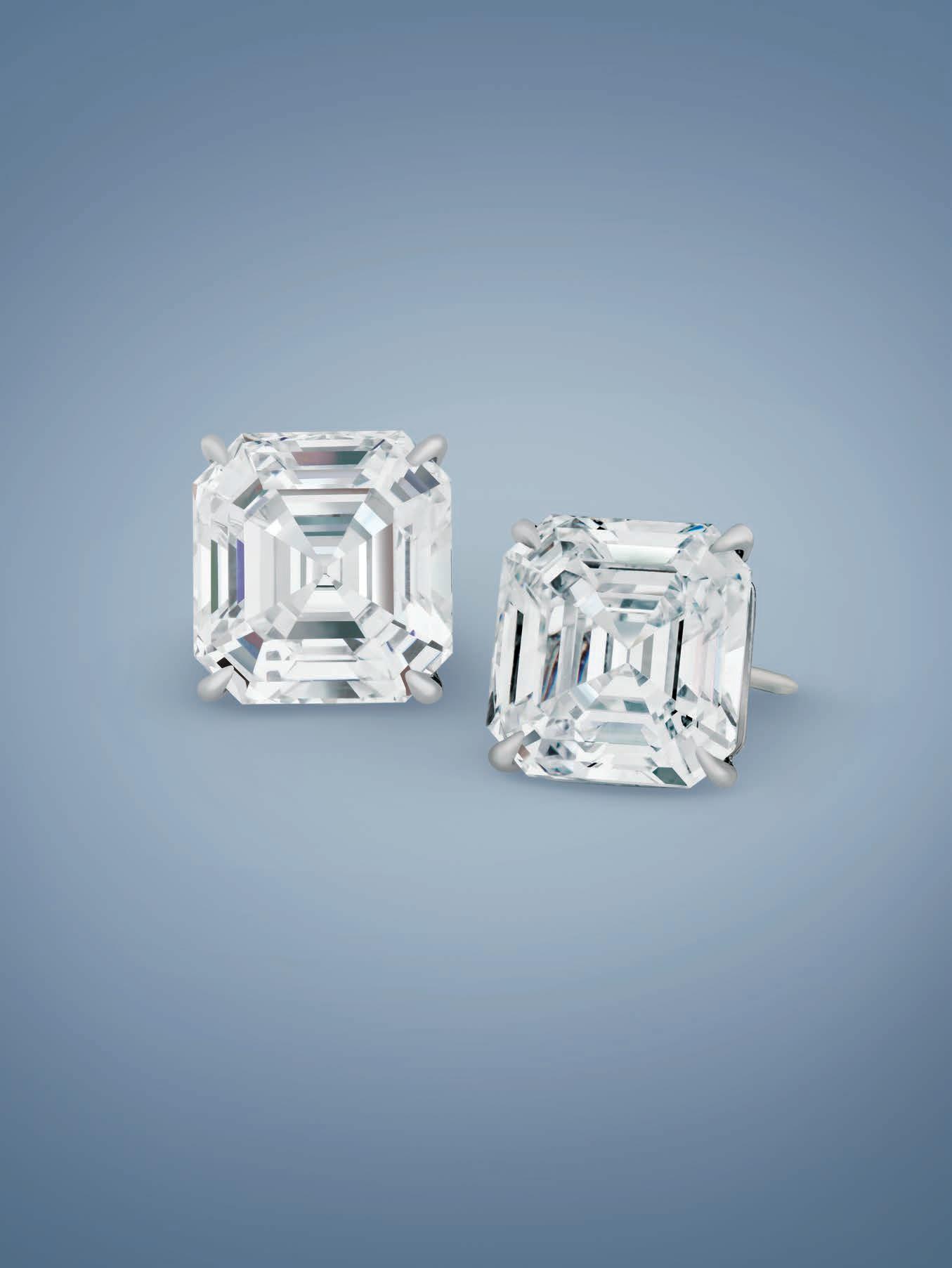

msrau.com • Best of the Best • 85
BRAZILIAN ALEXANDRITE RING
Alexandrites are rare gemstones that display the coveted color-change phenomenon, which means the stone can exhibit different hues under different light conditions.
The impeccable 6.67-carat Brazilian alexandrite at the center of this ring possesses the remarkable ability to change color. Alexandrites that hail from the mines of Brazil are prized for exhibiting the greatest color change phenomenon, with stunning bluish-green hues under white light and rich, deep purples when viewed under incandescent light. This brilliant-cut example is certified by the Gemological Institute of America as being a natural alexandrite of Brazilian origin.
While the alexandrite was first discovered in the Ural Mountains of Russia in the 1800s, many of the finest examples of these stones have been found in Brazil. For example, the 17.08-carat stone known as the Whitney Alexandrite can be found in the Smithsonian Museum of Natural History, having been gifted to the National Gem Collection by Carolyn Wright Whitney. Like the present stone, the Whitney Alexandrite changes from bluish-green in daylight and fluorescent light to an intense purple in incandescent light. In terms of both rarity and originality, these Brazilian alexandrites outrank nearly every other known gemstone.
GIA Certified | Alexandrite: 6.67 carats | Diamonds: 2.21 carats | Platinum | #31-5280
Scan to watch a video of this ring
Scan to view the AGL Appendix Letter


86 • Best of the Best • 866-349-0378


msrau.com • Best of the Best • 87
RUSSIAN EMERALD RING
The gemstone at the center of this ring has captivated the gemological world with its unparalleled quality.
An exquisite and rare 7.16-carat Russian emerald centers this spectacular ring. A remarkable gemstone of unmatched quality, this emerald won the prestigious “Best in Show” award at the American Gem Trade Association awards in 2018, and comes with the coveted appendix letters from the Swiss Gemological Institute and the American Gemological Laboratories with additional certifications by the House of Gübelin.
Possessing the vibrant saturation for which top-quality Russian emeralds are prized, this unique gem radiates a mint green hue, with its distinctive emerald cut offering numerous vivid internal color reflections. The incomparable emerald is remarkably free of any fissures, making clarity enhancement or filling impossible — it is an all-natural triumph.
This ring features two shield step-cut diamonds, further amplifying the dazzling beauty of the green gem in the center. Totaling 2.06 carats, the diamonds are certified by the Gemological Institute of America as being type IIa, the very finest D color and Internally Flawless. Type IIa diamonds are the most chemically pure diamonds with exceptional optical transparency. The unparalleled pedigree of this remarkable ring is matched by its spectacular brilliance and superb beauty.
AGL, SGI, GIA, and Gübelin Certified | Emerald: 7.16 carats | Diamonds: 2.06 carats | Platinum | #31-5082
Scan to watch a video of this ring
Scan to view the AGL Appendix Letter


88 • Best of the Best • 866-349-0378






















msrau.com • Best of the Best • 89
BURMESE
FANCY VIVID PINK SAPPHIRE RING
Marked by an incomparable magenta tone, this ring makes a colorful statement.
This completely untreated pink sapphire of magnificent quality and extraordinary color is simply unparalleled. A vibrant natural marvel, this astounding and rare 10.03-carat sapphire shines with a matchless vivid magenta hue. The incomparable color is matched by its superb cut and clarity. Certified by the American Gemological Laboratories as Burmese in origin, this incredible pink gemstone is completely unheated, emphasizing the coveted majesty of these gemstones in their natural state. For a sapphire of this size to display a color so intense without any treatment is a miracle of nature.
This beautiful natural gem is faceted into a rare round brilliant cut, a shape that is simply unseen for sapphires in this grand size, giving the stone an exceptional brilliance. Further, this pink sapphire displays a perfectly even color distribution throughout the stone, with absolutely no color zoning, underscoring the expert quality of the stone’s cut.
A phenomenal rarity, Burmese sapphires are among the most desired gems in the world. Admired for their intense color and brilliant splendor, the stunning Burmese sapphire featured in this ring, with its unprecedented clarity, superlative cut and entrancing hue, is certainly the finest of these gemstones available today. To uncover a gem like this is a once-in-a-lifetime rarity. Joined by two D color, Internally Flawless pear-cut diamonds totaling 1.51 carats, the jewels shine in their platinum settings.
AGL Certified | Pink sapphire: 10.03 carats | Diamonds: 1.51 carats | Platinum | #31-5371
Scan to watch a video of this ring

90 • Best of the Best • 866-349-0378


msrau.com • Best of the Best • 91
HIGH LUSTER SOUTH SEA PEARL NECKLACE











Celebrated for their impressive size and brilliant shine, large South Sea Pearls with a rose-toned orient are one of the rarest of the sea’s treasures.




Graduated South Sea pearls with high luster comprise this resplendent necklace. Hailing from the warm waters of the South Pacific, South Sea pearls are renowned for their large size and peerless shine. The largest of these pearls measure to 20mm, an exceptional rarity as these pearls rarely exceed sizes of 19mm. Further, rose-toned orients are the rarest overtone for white South Sea pearls. Ranging from 17 to 20.6mm, these pearls are truly incomparable with their impressive size, mirror-like sheen and distinctive pink overtone.
A string of this quality and tone is an exceptional rarity. This magnificent strand is completed by an 18K gold, diamond encrusted clasp set with 5.25 carats of white diamonds.
Pearls: 17-20.6 mm | 19” length | 18K white gold | #31-6260
Scan to watch a video of this necklace





92 • Best of the Best • 866-349-0378





























msrau.com • Best of the Best • 93


94 • Best of the Best • 866-349-0378
THE MONUMENTAL SÈVRES CLOCK MADE FOR KING LOUIS
PHILIPPE

Specially designed and created for King Louis Philippe for his palace at Saint-Cloud, this Sèvres clock became a gift to demonstrate the king’s gratitude for a selfless nobleman.
King Louis Philippe commissioned leading Sèvres designer Jean-Charles-François Leloy to draft designs for a clock for his dining hall at the Château de Saint-Cloud, along with a complementary set of coupes. Leloy was a highly regarded Sèvres designer, who worked with many monarchs and notably crafted the famed “Clodion” vases now at the Louvre. As a nod to the intended dining hall setting, the clock features cornucopias fashioned in bas-relief biscuit porcelain and a central plaque depicting a “repas antique,” or a painted porcelain panel featuring Classical figures as they dine and drink merrily.

Originally intended for the royal dining room, this exceptional timepiece has a moving story. The son of the king and heir to the throne, Prince Ferdinand Philippe d’Orléans, had set out from the Palais des Tuileries for a visit to his parents in Neuilly-sur-Seine when tragedy struck: losing control of the horses, the prince was thrown from the carriage and sustained fatal injuries. The prince passed away shortly thereafter on the lands of the king’s friend, the Marquis d’Aligre. The marquis gave his land where the Duc had died to the king and built the memorial chapel to the late prince — the Notre Dame de la Compassion. Louis Philippe was so moved that he gifted this magnificent clock to the marquis and engraved an inscription on the back panel thanking him for his immense service to the grieving royal family. Every work of art has a story to tell, but the impressive history and emotion held by this exquisitely crafted timepiece is extraordinary.
Dated 1842 | 40”h x 20”w x 12”d | #31-5711
Scan this code to watch a video of this Sèvres clock’s movement


msrau.com • Best of the Best • 95
DESHAYS À PARIS MONTH-GOING REGULATOR CLOCK
A testament to the firm’s artistry and superb craftsmanship, multiple aspects of this complex timepiece’s workings are exceedingly rare.
This Louis-Philippe-period month-going longcase regulator clock is an exceptional example of French clockmaking, and its complicated mechanism marks several different aspects of passing time. Crafted by Deshays à Paris, the timepiece displays sleek silvered steel dials that indicate the time, date, month, equation of time and weight descent. The outer chapter ring indicates the time in Roman numerals with three blued steel hands, including two Breguet hands and a seconds hand, and under the main dial sits an engraved silvered wheel that displays the date and month.
This clock features three highly rare complications: a month-going movement, equation of time and weight descent. Within the chapter ring lie two semi-circles. The upper circle is engraved with the French phrases Soleil avance and Soleil retarde meaning “advancing Sun” and “receding Sun,” simulating solar time as it would be shown by a sundial. The lower circle is marked “Descente du Poids” or “weight descent” and is engraved with indications of the weeks, showing the changing position of the driving weight. This mechanism serves as a countdown to when the weight will need to be raised again to keep the clock running accurately.

The case, neoclassical in style and crafted of striking “bird’s eye” mahogany, is a work of superb artistry. The structure features a dentil frieze, an elegantly sloped cornice and a tall, molded quadrangular base. The case’s understated, balanced composition highlights the beauty and complexity of the clock’s dial and pendulum. The pendulum itself boasts another interesting trait — a pyrometer device that bears information on the temperature of dilation of metal. Once primarily found in prominent public and government buildings, regulator clocks have been the most accurate of the weight-driven clocks since their inception. This exquisite regulator would have been the master clock to which all other clocks and watches within a building would have been set.

Marked “Deshays à Paris” | Mahogany, rock crystal and silver | Circa 1830 255/8”w x 141/2”d x 911/2”h | #31-3802
Scan to watch a video of this regulator clock’s movement

96 • Best of the Best • 866-349-0378

J.C. JENNENS & SONS MONUMENTAL THREE-TRAIN BRACKET CLOCK
Every aspect of this clock displays expert craftsmanship, making the timepiece a mechanical and visual delight.
Intricately detailed, this 19th-century bracket clock from famed English firm J.C. Jennens & Sons is monumental in size, likely made for one of the great world exhibitions or perhaps displayed in the firm’s own store window. The eight-day timepiece has a triple fusée movement with both ten bells and five gongs. The internal movement weighs an incredible 80 pounds — nearly ten times larger than an average bracket clock. Uniquely, this timepiece is not a pendulum clock and instead utilizes a balance wheel escapement, a rarity for clocks of this size, which ensured one would not have to reach into the back of the clock to start the movement. Every detail of the movement, including the beautifully hand-engraved backplate, demonstrates painstaking attention to detail.

The clock’s lustrous ebonized body is accented by elegant gilt bronze motifs. Intricately detailed with a total of six dials to indicate the time, date, day of the week and month of the year, the face also includes dials for multiple chime settings. Each bronze dial is encircled and crowned by foliate motifs and cherub faces.
In his book Amazing Clocks, Derek Roberts, the preeminent authority on English clocks, remarked that a similar bracket clock was the largest example he had ever seen. To demonstrate the rarity of this creation from J.C. Jennens, this 59-inch tall clock, not including the custom base, is an incredible three times larger in total square inches than the largest timepiece Roberts had ever seen. Exceptional in both craftsmanship and ingenuity, this clock is a work of art.
Circa 1880 | Clock: 563/4”h x 381/4”w x 201/4”d Base: 351/4”h x 391/4”w x 221/4”d | #31-5945
Scan to watch a video of this clock and its inner workings

98 • Best of the Best • 866-349-0378




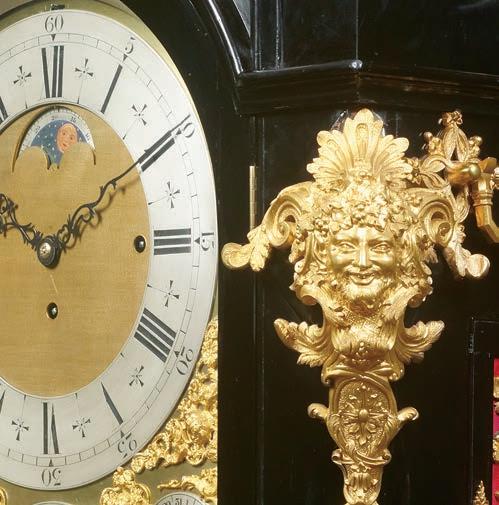
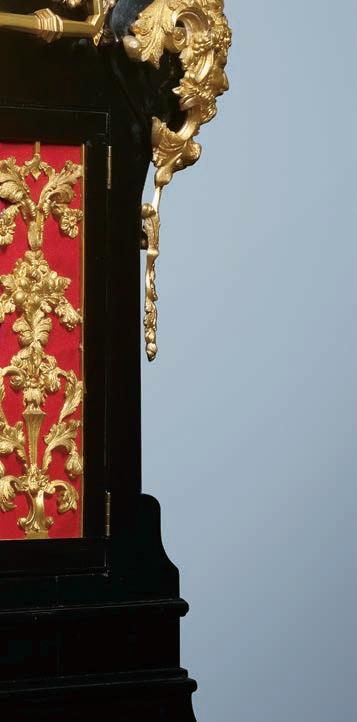

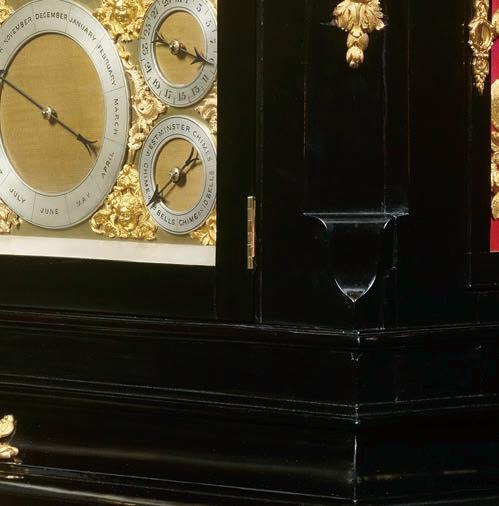
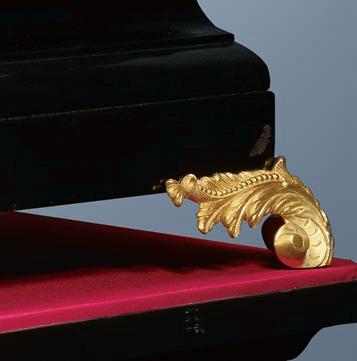

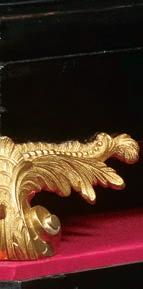

ROYAL ITALIAN WRITING DESK WITH SECRET COMPARTMENTS
Created for King Carlo Alberto of Sardinia, this exceptional desk and armchair are exquisitely carved and inlaid, and both hide numerous secrets in plain sight.
This exquisite desk and chair, crafted of the finest Cuban mahogany and meticulously inlaid with the finest satinwood and boxwood, are among the most impressive royal furnishings. The corners and sides feature carvings of foliate swags, scrollwork, leaves and heraldic roses, symbolizing King Carlo Alberto’s family, the House of Savoy. Woodcarvings of lion heads don each corner of the table and the legs end in strong lion paws, a reference to the majesty and military prowess of the crown. The chair is equally elaborate, featuring matching carved motifs and beautiful red velvet upholstery.

Closer inspection of the desk reveals further fascinating details within, including a myriad of hidden compartments and drawers. Dozens of compartments are concealed within the beautiful structure of this desk, accessible only with the proper know-how. On the front of the desk, two identical compartments open at the turn of a key, each showing architectural facades featuring a bust of Socrates surrounded by hidden drawers disguised as columns. Other highlights include a concealed writing desk that pops out with the press of a button, as well as a centerpiece that lifts from inside the desk; the decorative element portrays the eagle with its wings spread, a symbol of the Roman Empire. Glorious in both design and ingenuity, it is one of the finest handcrafted desks of the 19th century. To get a sense of the desk’s complexity, words can only demonstrate so much; please scan the code below to watch an in-depth demonstration of this desk’s fascinating features.
This desk would have been highly effective for the safekeeping of sensitive documents and valuable items, a necessity for a king. King Carlo Alberto forged many political actions from revolutionary to absolutist, meaning there was never a shortage of confidential correspondence and political plans to be stored. Given that he had many servants and workers in his space, it was imperative that these sensitive documents be hidden carefully — thus, the need for many hidden compartments.
Mahogany | Circa 1840 | Chair: 23”w x 363/8”h Desk: 541/2”w x 33”h x 323/4”d | #31-5856
Scan to watch a video of Bill Rau exploring this desk’s secret compartments and history



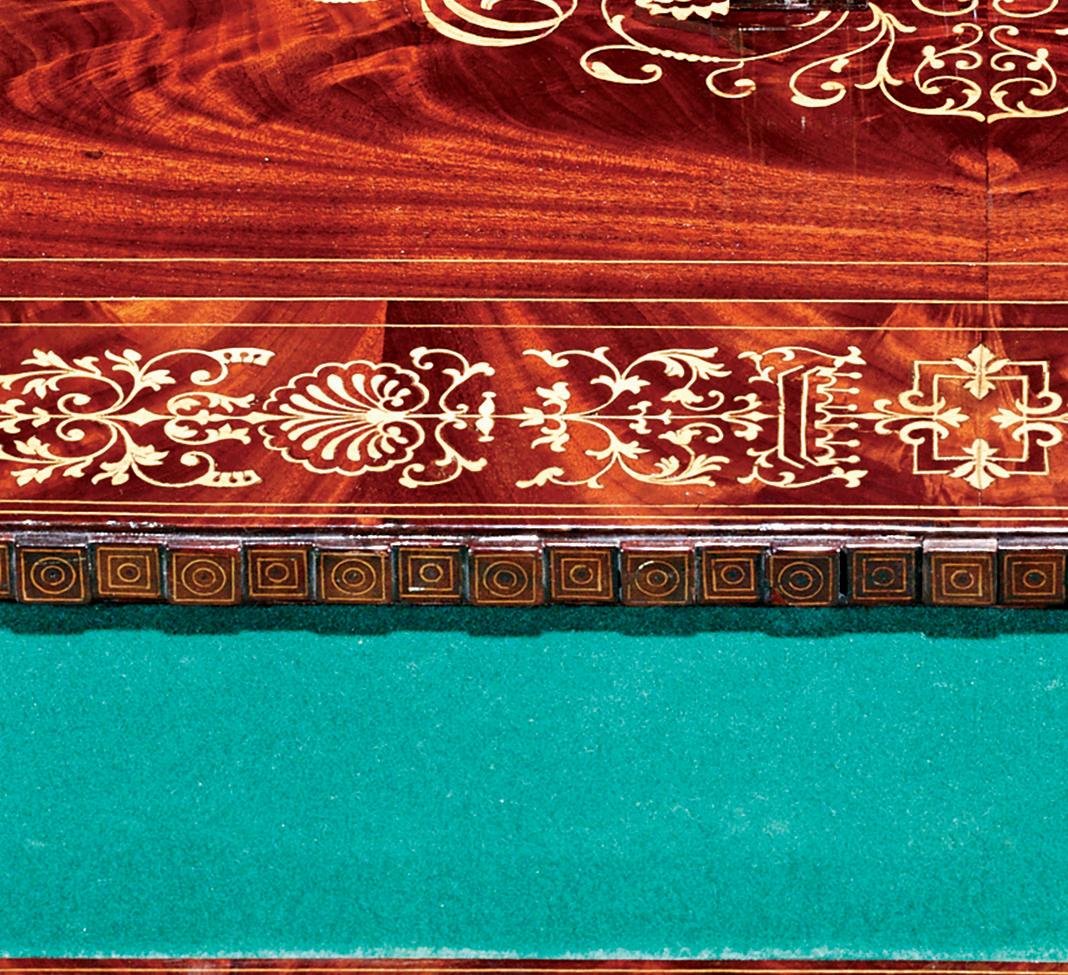



msrau.com • Best of the Best • 101



BUY WITH CONFIDENCE
M.S. Rau believes that exceptional, museum-quality treasures and superior customer service go hand in hand. This 110-year-old philosophy has allowed us to build lifelong relationships with clients from around the world by earning their trust one purchase at a time.






ACQUISITIONS & AUTHENTICATION

All of our acquisitions are selected and evaluated by our team of experts, led by Bill Rau, ensuring every work in our gallery has been thoroughly researched and expertly vetted for quality and authenticity.
ON APPROVAL
Many of our pieces can be sent to you on approval so you can experience the piece in your home. If not completely satisfied, you may return your item, in the exact condition as when it was shipped, for a full refund, less shipping. Ask your Sales Consultant for details.




RETURNS & OUR 125% GUARANTEE

Each piece we sell is backed by our 125% Guarantee. Anything you buy can be returned by you, in the same condition as when you purchased it, for a store credit on any other like item we own at the marked retail price, including 5% appreciation annually for up to five years following the sale. See complete details at msrau.com.

PROFESSIONAL PACKING & SHIPPING
All of our packages are professionally packed on site by a specially trained member of our shipping team. We can ship any item to any destination in the world safely, expeditiously and fully insured.
Scan to sign up to receive text


messages from M.S. Rau
Follow us on social media to learn about our latest acquisitions, special exhibitions and more







































 JACOB LAWRENCE
JACOB LAWRENCE













































































































































































































































